Kristen Lamb's Blog, page 7
April 6, 2022
Literary Larceny & Why People Should Be Ashamed

Literary larceny is a new ‘trend’ that is normalizing stealing from authors. Stealing from authors—or anyone for that matter—is NOT okay. I know, I know. Some topics I shouldn’t even have to blog about. I mean what’s next for blog topics? “The Great Wonders of Using Toilet Paper,” “Why Kicking Puppies is Wrong” “Top Five Reasons Not to Eat Tide Pods.”
Yet, here we are. I know I just posted, but this couldn’t wait. It’s…it’s a problem.
Some people—not all people—should be deeply ashamed that I even have to post on this.
What is literary larceny? Other than a clever use of alliteration? This is when people believe, for some odd reason, that it is perfectly okay to buy an ebook, read it in full then return it…and just keep doing this repeatedly without ever actually paying for a book.
According to the article Writers riled by Amazon offering refunds ��� after readers finish ebooks 4/3/22 by Rosamund Erwin and Liam Kelly:
The trend appears to be driven by users of TikTok, the video-sharing platform that has engaged many young readers through the hashtag #booktok. Videos about returning ebooks have been viewed more than 17 million times. Some users provide tutorials on how to return books after reading them.
The Sunday Times
I wish I were making this up.
It is bad enough some people are stealing, but then they go make How-To videos to help train NEW thieves?
Did Kindergarten teach y’all nothing?
Literary Larceny & Lending Libraries
Before we go any further, I’m no stranger to this topic. My blog ‘Pay the Writer’ went viral in 2015. I wrote the blog in response to an article claiming that buying used books supported writers.
Eh. Not really. It was part of the whole ‘exposure’ schtick. I asserted that if readers actually wanted to support their favorite authors, to try and buy something NEW because used books didn’t pay any royalties.
If writers don’t make any money, we cannot afford to keep ‘working’ as a writer. When I wrote that article, Huffington Post had all but single-handedly demolished most freelance work that once paid really, really well.
Just go open up your copy of Stephen King’s On Writing where he talks about how much he was making on magazine pieces while he was building his career.
In the 1980s and 1990s, magazines were paying hundreds if not thousands of dollars for well-crafted articles. But, by 2015, major sites like Huffington Post expected writers to work for ‘exposure dollars’ (as in FOR FREE) and be grateful anyone would deign to read our content.
***Meanwhile, Arianna Huffington cashed out to the tune of over $300 million in real dollars.
Why do I bring this up?
Two reasons.
First, many of my critics blasted me claiming that, if I didn’t support used bookstores (patently false) then clearly I must also hate LIBRARIES since people didn’t pay money to borrow a book.
So we don’t do this dance again, let’s check out how lending libraries work (pardon the pun).
Buying and returning ebooks nonstop is NOT even CLOSE to the same thing as going to a library.
Libraries can actually be VERY lucrative for authors. Contractually, libraries BUY the rights to the copies of the books on their shelves. The library can only loan out those books so many times before, BY CONTRACT, they must remove the book and BUY RIGHTS TO/COPIES OF A NEW ONE.
Yes, this was why the library charged you $75 to replace the $5 paperback you lost. They had to recoup what they had to pay the author.
The same goes for libraries who lend out ebooks. The library can only loan out that ebook a set number of times. Once they pass this number, the library has to renew this process if they want to keep loaning out the ebook.
Lending libraries are awesome. Writers make money. When writers make money, we can write MORE books.
Literary larceny is not the same as a lending library.
One is supporting authors and the other is a level of entitlement I cannot wrap my head around. Oh, and it’s stealing. There are massive short and long-term consequences for this.
My second reason I bring up this old post?
Normalizing Literary Larceny Bad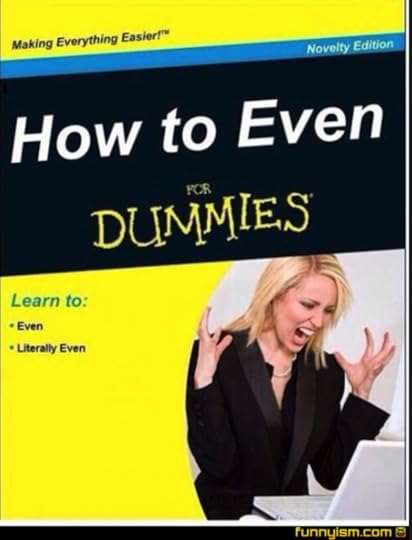 Me.
Me.Expecting writers to write for free is not new. Like many other creative professions, we’ve been fighting this battle for a long time. But I addressed this entitlement back in 2015. Why? Because I spotted a pattern of behavior we needed to stop.
If people bought used copies and LOVED the book? AWESOME. All I asked was that they then please buy something NEW so the writer could pay her bills. No big deal.
Oh, but it WAS.
The sheer level of entitlement I encountered with that post absolutely FLOORED me. Apparently, I had some nerve. If I wasn’t making any money, then maybe I was a crap writer and needed to get another job. Writers were a bunch of whiny babies who needed a real career.
Sadly, I lost count of all the justifications for why it was totally appropriate to expect writers to work for free.
Far too many people utterly missed the point. Readers DID value what the writers created. They valued those books enough to buy them…used. My contention was simply that writers had to make money if readers wanted them to write more books. If readers wanted more books, then please buy something new.
Not rocket science. And not unreasonable.
***Creative professionals already give a ton of stuff for free (YouTube videos, memes, images on places like Pexels, blogs like MINE).
The problem, however, was this. The Internet had already started normalizing FREE and had unwittingly cultivated a culture of entitlement. I saw the writing on the wall. If we didn’t educate readers and allowed the entitlement to thrive, eventually it would be a monster raging out of control.
And here we are.
Btw, please don’t eat Tide Pods.
Don’t believe me? What IS stealing?
If I walk into one of the few remaining Barnes & Nobles and put a stack of books into three giant tote bags and walk out, that is STEALING. Oddly, if I walk into a used bookstore, load up a pushcart full of books, then walk out without paying, guess what that would be called? Again. STEALING.
In fact, I’m pretty sure if I strode into a library and loaded up bags full of books and just left? Probably considered stealing as well.
But, if I buy and return ebooks to my heart’s content and never actually pay to read any of those books. This is, oddly…NOT STEALING?
That’s bull sprinkles! Where did we get this math?
For people who are on a budget, check out books from a library. Sign up for Kindle Unlimited where you can read or listen to thousands of titles for a small fee paid monthly. Writers might not make as much but at least they’re not being flat out ripped off.
Look for titles the authors are willingly and knowingly offering for FREE. Writers are some of the kindest, most amazing people in the world. Generous to a fault. Ask me how I know.
Amazon, Step Up on the Stealing Stuff
Jeff Bezos all but declared open war on NYC Big Six publishing (Re: Amazon Publishing: The Road to Conquest & How Bezos Razed New York). Sure, Bezos began Amazon selling everything online but books, but he always had his sights on taking over big publishing.
Which, you know what? Fine.
As far as I can recall, he wanted publishing to be more egalitarian. He dreamed of a system where authors could be paid fairly. Those writers who produced a lot of content the public loved would be rewarded accodingly.
I’m all for that.
Amazon has done some great things. Not denying that. On this book stealing stuff though? Uncool. Seriously uncool.
Great, Amazon dismantled Big Publishing and crippled Barnes & Noble. That was part of the plan. But, after single-handedly burning our industry to the ground, I feel Amazon has a responsibility to all the authors they’ve displaced.
You don’t get to overthrow the literary leaders and take over the pack, only then to throw the pack under a bus.
Amazon wanted to remove a system with agents, editors and publishing houses—institutions that had traditionally fought for author rights—and that’s all well and good.
Now step up.
Amazon, I am NOT totally hating on y’all because that is just low-hanging fruit, not to mention largely erroneous.
I get it has not been easy. I’ve been here for the entire rodeo. I understand how much fraud y’all have had to discover and disrupt. From bots ‘fake reading’ KU books to bait-and-switch scams, to locating Chinese counterfeit books, y’all have done a lot.
But that’s the price of admission into the digital world.
Literary larceny is NOT okay.
Protect Your Writers from Book Theft
Yes, there are still publishers around and a smattering of bookstores. This said, by and large, most everything else book-wise has to be run through Amazon. This is why I feel this company has a moral obligation to protect their authors.
I get it. Bezos didn’t like Big Six publishers.
Amazon’s core arguments for bulldozing traditional publishing was because the Big Six were so ridiculously bad at business. Granted, that is a sound argument. But fast forward to now—where authors really have no other viable option where to sell their books—and Amazon’s brilliant plan is to enable people so blindly entitled they actually believe stealing is a friggin’ ‘life hack’?
Under the current guidelines, readers can return an ebook within 14 days even if they have read the entire book. Then, Amazon deducts the royalty from the author.
Granted, I like a solid return policy. I’ve been with Audible for almost four years and I’ve returned books. That is a privilege that comes with my membership, but one I rarely use. I’ve completed almost 340 titles since joining. Trust me. Writers are making a LOT of money from me.
Stealing is Why We Can’t Have Nice ThingsI like companies with liberal return policies. It makes life easy when I don’t have to fill out a stack of paperwork, submit a DNA sample, a horoscope and three letters of reference just to get my money back.
Amazon, you have been too nice. Walmart, Target, Sam’s and Costco all went through this, too. You give a generous return policy, but then there are those people. Those people are why we can’t have nice things.
Eventually these companies started taking down people’s driver’s license numbers. Return too much and too often? Banned from returning stuff….cuz it is a form of stealing.
Why am I calling out Amazon? Because this is a problem of SYSTEMIC PROPORTIONS and changing the return policy is a stopgap measure (until these @$$hats find a new way to steal books).
Systemic Stealing
In 2015 I wrote post after post after post trying to make people wake up to the growing sense of entitlement in our world. We have entire generations who’ve grown up on memberships and streaming services and being entertained 24/7 via the internet and social media. I don’t know if the people on TikTok even understand what they are doing.
I mean, in 2015 Salon dot com did a hit piece on me in response to ‘Pay the Writer.’ Used bookstores around the world vowed to ban my books. Readers vowed to never buy my books from used bookstores.
Um…huh? Wait no. Um never mind. *throws up hands*
People failed to grasp that writers didn’t make money off used books. Maybe the folks on TikTok don’t realize that returning ebooks is seriously hurting writers. I like to give the benefit of the doubt.
I believe in education.
For those who didn’t know any better before now? Please stop. For those who now know better and don’t care? Shame on you. Don’t complain when your favorite authors stop writing because they couldn’t afford to work for free anymore.
And, FYI, karma’s a doozy.
If anyone reading this is active on TikTok and sees these videos? Speak out. Report them. Let them know that literary larceny is NOT cool.
Know Your Worth
This is a conversation I have had many times on this blog. This starts with us…with writers. We have got to start valuing what we do and what we contribute. If we don’t value our books, who will?
This is why I have a very specific way of teaching how to build an author brand. Ideally, we want to use social media and blogging to cultivate an audience of fans. I teach HOW to do this in my book.
Fans would never even think of stealing from their favorite authors. In fact, fans will shut down stealing from their beloved scriveners. I know, because many of you guys have messaged me over the years to tell me when my books were being pirated.
Just know that it is okay to ask for the sale.
FREE is a legitimate marketing strategy. It is why I encourage writers to write series. Offer the first book (the loss leader) for free and, if you’ve written a good book, odds are good that people will then feel much more confident buying the rest of your books.
This is how authors make so much off me on Audible. I’ll listen to an audiobook, find out it is part of a series, then be willing to donate blood to buy credits to finish out the entire series.
All in all, just know you deserve respect. The world is NOT entitled to take all they want at no cost. You matter. Your work matters.
Literary Larceny & the High Cost of FREE
Returning ebooks might not seem like a big deal, but with most bookstores now shuttered, this is it. The end of the line. If we (fans, readers) fail to support the books and authors we love, they will go extinct.
Right now it seems there are so many writers and so many books. It seemed that way to sailors and Dutch settlers who wiped out the Dodo bird. At one time, hunters thought buffalo were as numerous as the stars, until they nearly obliterated them. Same with the whales, the wolves, the rhinos…and now the writers.
We should all be careful what we take for granted. It would be a sad day to wake up and there are no teachers, no dreamers, no thought leaders. All are like the Dodo bird, relics of a bygone era.
The future is now. Which way this goes is up to all of us.
To Do More About Literary LarcenyIf you’d like to do more, please sign this petition to get Amazon to change their return policies. I know this is a MUCH larger problem, but right now we have to stop the bleed.
Literary larceny hurts everyone. In fact, creatives as a whole are really struggling. Some things I do to help support creatives? Pexels allows you to donate to photographers. I also support some of my favorite content creators by donating to their Patreon and I buy downloads of favorite songs.
If you do read a book (free or not) leave a review. Even if your review is short this jukes the algorithms and helps our sales.
And, because Harlan Ellison is AMAZING and this never gets old, you’re welcome (FYI there is language in this, as is to be expected)…
The post Literary Larceny & Why People Should Be Ashamed appeared first on Kristen Lamb.
April 5, 2022
Memory: Shape Characters & Sharpen Conflict

Memory is a tricky thing. We like to believe our brains are like a video camera recording every detail of every event with perfect precision. Or at least I’m guilty of believing this…especially when at odds with someone.
But, aside from memory making us martyrs, it serves many other useful purposes in life and in fiction.
I honestly did not appreciate how important our memories are until I created what I thought was a clever character. The premise of my story was, “What if DNA could be hacked? What if humans could be deleted?”
Cool idea and one I still work on when not doing the paid work. But, to be blunt, I wrote myself into a corner.
How? I failed to properly appreciate memory. While it was clever to think of humans in terms of machines made flesh, it doesn’t really work that way. Or at least that is what I realized once I was a good ways in.
Since the premise involved, essentially ‘hacking’ humans, one of my main characters had no memory. He’d been ‘wiped’, to use the computer term.
But was that even possible?
Memory is the Human Operating System
For those who are NOT computer nerds, every computer has to have a core OS (operating system). When a tech wipes a computer, that computer cannot be totally blank or what we’re left with is a VERY expensive piece of plastic with metal bits.
Without the kernel, the computer cannot function. It has no way of running any basic operations, let alone any software.
What does this have to do with people?
Memory, in large part, is the core of WHO we are. This is why dementia is such a terrible disease. That is a form of degenerative memory loss that is impacting the core of the person, which is why, in advanced stages, those suffering eventually forget how to talk, swallow and breathe.
There are many forms of amnesia that usually fall under the banner of retrograde or anterograde amnesia. Anterograde amnesia is the inability to form long-term memories. Think of Dori in Finding Nemo (refer to What Finding Nemo Can Teach Us About Story Action).
Retrograde amnesia is the inability to recall information before a trauma, operation or whatever caused the memory loss (think The Bourne Identity).
The key thing to me is that the memories are still THERE. The data might be in fragmented bits but it still exists. It is all a matter of retrieving the information and cobbling the pieces back into something meaningful.
No Such Thing as a Tabula Rasa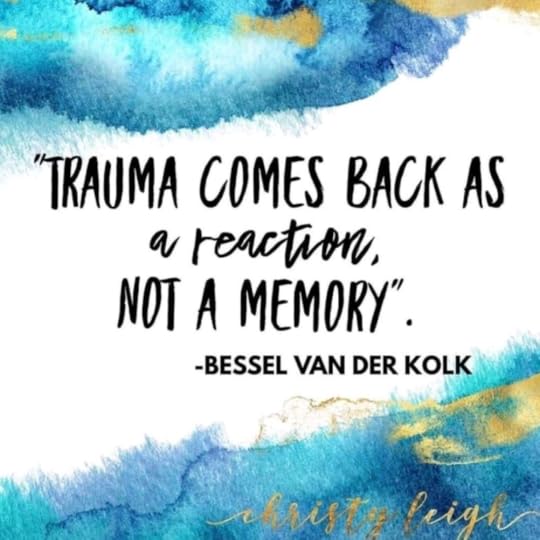
Some psychologists, sociologists, psychiatrists, etc. once speculated that humans, at birth, were what’s known as a tabula rasa or a “blank slate.” This meant that any problems or peccadillos had to be an offshoot from environment and nurture. Given the right home and upbringing, any child could be a prodigy or at least a functioning member of society.
However, the idea that humans were all equal blank slates to be molded in any form, didn’t neatly fit with reality. We all have a unique genetic makeup. Humans are each born with certain traits, strengths, and weaknesses that upbringing alone simply cannot account for.
So the idea that I could have a character who’d been completely ‘wiped’ quickly devolved as I wrote. First, he’d have certain genetic predilections that might make him naturally more aggressive, more intelligent, less emotionally sensitive, or whatever.
Then, he still had to have at least SOME fragments of his old life somewhere or he’d be useless. How would he remember how to drive? Fire a gun (it was a sci-fi thriller)? His combat training? Granted, it was a simple enough fix.
All in all, it was better to suppress his memories, not erase them.

I merely use this example to point out a) even I am the victim of my own ‘cleverness’ and b) I underestimated just HOW much we rely on memory for basic survival.
Anyway, I wasn’t too far in when I realized a character who’d been ‘wiped’ of all memory couldn’t have an accent, an opinion, formulate higher thinking without older memories at least being present in some form.
Even if these older memories were running as an unconscious subroutine, something had to fill the void. If not? He’d be a boring, if not utterly useless automaton.
In short? Memory makes man.
Character and Memory
In the beginning of the post, I mentioned how some believe(d) that the brain really does record everything exactly as it happened. If we can’t remember a certain event, it’s simply because, for whatever reason, we cannot access it (like accessing a file).
The movie The Final Cut, starring the late, great Robin Williams did an interesting job of challenging this notion of true memories versus those formed organically. In the movie, the wealthy can have what is referred to as a Zoe implant surgically inserted into infants.
EYETech records every detail of what a subject sees. Upon death, special techs known as ‘cutters’ then edit out all the bad and truly horrible stuff and create essentially a montage for posterity.
The movie does a fabulous job of juxtaposing what REAL memory is against what we BELIEVE is real. For instance, if memory serves me right (*bada bump snare*) there is a scene at a funeral. One of the grieving family members watches the Zoe film from a lost loved one and adamantly insists the color of a boat was a totally different color.
But the Zoe is an ACTUAL recording, so it can’t lie. Emotions hold no sway. Zoe memories cannot be multiple memories compressed into what seems to be a solid singular recollection.
See how memory can already create tension? One character recalls an event in a totally different way. Maybe the trauma suppressed certain details or the ‘memory’ is actually several different events fashioned together?
What FORMS Character?
When creating characters, we must keep in mind what forms what we call ‘character’? What makes words on a page come to life and feel more alive than people around us? In short, our jobs as writers is to create resonance.
How to do this? We use the character triad. The Wound, because pain deepens our stories. Then, there is the Blindspot and, finally, Shame. All three of these are inextricably bound. Wounds are often a source of shame which can also then create a blindspot. Weirdly enough, the answer to that which vexes us most is often found in the one place we cannot SEE.
This is why therapists will always have a job. Their role is to help us see beyond the haze of pain and calm down long enough to do some honest reflection. Why? Because our memories are often colored/edited because we were wounded.
When something traumatic happens, we humans automatically shift into reptile brain thinking. It is survival mode. This is why certain elements are crystal clear. Pupils dilate to allow in as much information as possible, but simultaneously, we fixate on the threat to the exclusion of other—possibly salient—information.
Adrenaline hard codes certain details to the necessary exclusion of others. This is one of many reasons why eye witness statements are grossly unreliable.
Emotion and Memory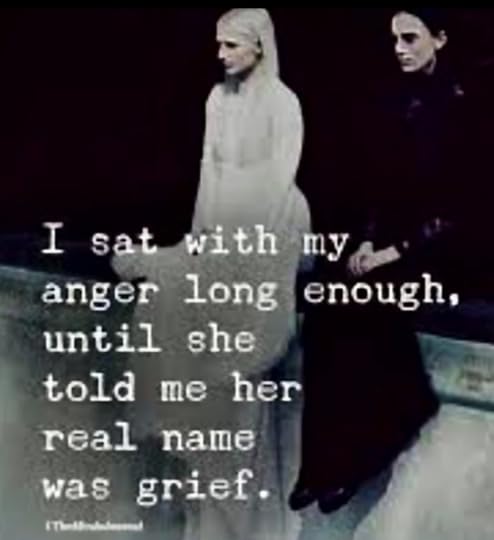
Have you ever had someone berate you in public and leave you, mouth gaping like a stranded goldfish? Then twenty minutes later you FINALLY think of the perfect comeback? But…it is too late.
Or, perhaps you lost your temper, said things you can barely recall? In the heat of the moment maybe you fell apart, lashed out, or retreated. Yet, it all seems a bit hazy.
This is the amygdala hijack.
Earlier we mentioned how humans shift into fight-or-flight when under duress. This can come with some complications later. Because our brain floods the system with stress hormones like adrenaline, cortisol and the like, it impacts how our brains then code the memory. Too often, we’re upset trying to piece together what happened using bits of our own memory and maybe some accounts of those who witnessed the events.
Suffice to say, this is NOT the cold, unbiased recording of a camera. It is human and flawed.
Reactions and Memory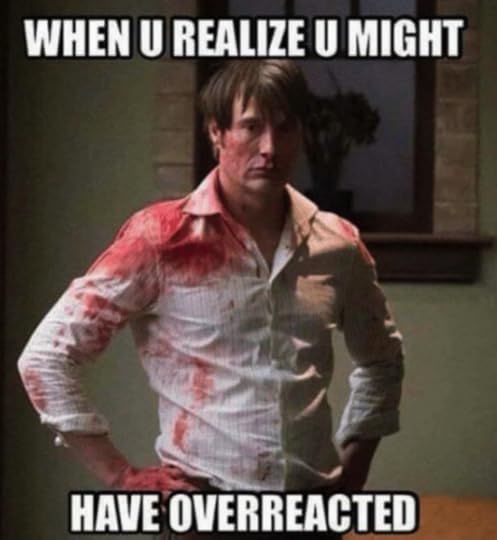
Have you ever had a bad day at work or home and completely overreacted? In my humble POV as a highly qualified armchair psychiatrist, this is because trauma often comes back as a reaction not a memory.
This is true with regular people, so why wouldn’t this also apply to dimensional characters?
Humans who always say and do the right/responsible thing no matter what are not very interesting. You never know who anyone really is until you put that person under pressure. If that sane, grounded, responsible person is STILL sane, grounded, and responsible after you (Author God) destroy their world? That is NOT the right character for riveting fiction.
Now, when that sane, grounded, responsible person suddenly acts in a way NO ONE could have ever anticipated? THAT is interesting.
I know this is an oldie but goodie. But since we are talking a lot about amnesia, residual memory and trauma, y’all remember the movie The Long Kiss Goodnight?
Samantha Caine is a wife, homemaker and schoolteacher. PTA meetings are about as exciting as it gets. But who is Samantha Caine…really? After being rescued from a near-fatal accident almost ten years previously, she’s rebuilt her life with no memory from her past.
That is, until a car accident and a head injury starts to jangle bits of her past back into her present. What’s been buried in Samantha’s subconscious is the key to survival not only for her but her family.
This was my favorite part of the movie.
Trauma and ResponseEveryone reacts to stress and trauma in different ways. As much as we’d like to say or believe something is in the past, is it? Really?
Memory is what makes paper-doll characters come to life. Too many new writers stop at surface description. If we want to describe hair and eye color, fine. Some genres (say, romance) almost require a detailed physical description. That, in and of itself, is not the problem. The problem is when we STOP there.
Why is your character brooding, dark, mysterious? Did your character choose their profession willingly or as some sort of compensation?
For instance, did your character become a doctor because she wanted to? Or because she was drinking and driving in college and ran down a teenager?
Maybe this terrible secret (guilt and shame) is WHY she chose to become the best trauma surgeon. Saving people is her penance.
What do your characters do when stressed? Do they pick a fight, drink, make jokes, walk away, shut down? WHY?Flesh out your characters and think how they then will conflict in the story. Someone who chatters away when stressed will drive someone who broods bonkers (think Donkey and Shrek).
Everyone has baggage. My rules when I was dating was a guy could have baggage, but carry-on only. For FICTION? The more the better. Story is how we RESOLVE trauma. And, as I mentioned earlier, trauma frequently comes back as a reaction, not always as a memory.
Humans are vastly complex. We are a product of all that has happened to us. Unconsciously, we are the result of what we either are too afraid or too ill equipped to deal with…so we stuff. Usually this coping mechanism works out fine…until it doesn’t.
Fiction should be full of all kinds of emotional triggers that will FORCE the protagonist to deal with demons they’d rather ignore. The story is the crucible, the fire that forces those bad memories/feelings/traumas to the surface.
In fact, the ONLY way for the protagonist to transform into a hero is to deal with what ‘baggage’ makes him/her too weak to take on the Big Boss Troublemaker at the very beginning.
They won’t want to remember, but they will have to. Memories make them who they are, good, bad, and ugly bits.
What Are Your Thoughts?Do you see how even coming up with a brief meaningful bio can make a massive difference in knowing your characters? A great exercise is to take your characters and write them IN a scene. You don’t need to use this bit of writing, though feel free to if it works.
Write them in a variety of different scenarios. What is the moment of their greatest victory or deepest shame? Place them in danger. How do they react? Do they shut down or strike out? Play around and get to know your characters. This will help you get the casting right and make tweaks ahead of time.
Any thoughts, comments, questions, suggestions? Can you think of movies or books that were SO AMAZING because the characters felt more real than those around you? What are some examples? Why did those characters stand apart?
I love hearing from you!
What do you WIN? For the month of APRIL, for everyone who leaves a comment, I will put your name in a hat. If you comment and link back to my blog on your blog, you get your name in the hat twice.
What do you win?The unvarnished truth from yours truly. I will pick a winner once a month and it will be a critique of the first 20 pages of your novel, or your query letter, or your synopsis (5 pages or less).
The post Memory: Shape Characters & Sharpen Conflict appeared first on Kristen Lamb.
March 24, 2022
SEO: The Key to Working Smarter not Harder
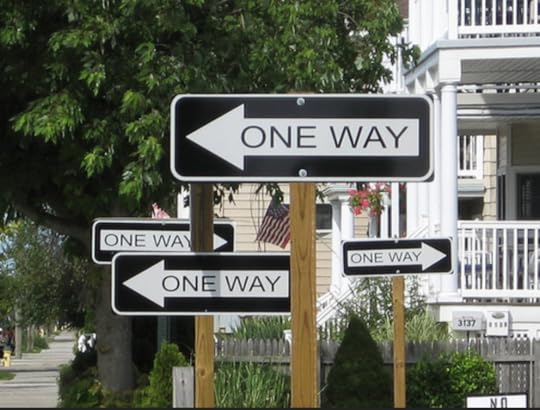 Um…HUH?
Um…HUH?SEO, for those who might not know, stands for Search Engine Optimization. And right now, many of you might be like, “Well, great. THAT makes it clear as mud.” Today, we’re going to talk a little about search engines, how they work, and ways search engine optimization can make our content work harder so we don’t have to.
For the record, one of the reasons I don’t blog a lot on SEO practices is they change…a lot.
Though, I’ll add a correction.
The core concepts of WHY we’re doing what we are doing do NOT change. That’s more what we’ll talk about in this post. When we know WHY we are doing X, Y, or Z, then that makes it far simpler to keep up with shifts in how SEO hands out favor.
I will also talk to the NOVELISTS out there. Yes, SEO can be a game-changer for you guys as well. It’s okay. Breathe in a bag if you need to. I’ll make this super easy.
First, why do SEO tactics change?
Before we get to the BIG PICTURE stuff, understand search engines have three core imperatives. The first is to deliver results quickly, and the second is to deliver the most accurate and useful results that also account for intent. Search engines are also vested in keeping those searching safe. They do this by running interference between us and malicious actors.
So, one reason we need to keep on top of SEO changes is because those who design algorithms are constantly seeking to improve search results. We definitely want to make use of any advantage we can get.
There are also people who try and game the system and garner unjust advantage. SEO modifications help neutralize any cheating.
My advice has never changed. If it seems like a shortcut? Just leave it alone. For instance, a few years ago, I adamantly warned people against buying external links (pingbacks)—pages outside linking back to a website to buff up SEO. I posited that eventually the algorithms would improve and spot the cheat and those who engaged in this practice would deeply regret it.
Quite a few folks didn’t heed my advice and major search engines responded by essentially penalizing their sites or even ghosting their sites completely.
Okay, so WHAT IS this GOOGLE Voodoo?
As I just explained, search engines exist to help us sort the vast realms of the Internet for what we want/need in a fraction of a second. HOW do they do what they do?
No, not magic but close.
And, for the record, this is a 50,000 foot view. There are tons of experts who go into far greater detail in books, blogs and videos. That’s beyond the scope of my blogs, since I mainly focus on writing and bigger picture branding and social media.
Hopefully, after this post, though, you’ll make better use of SEO tips and tricks out there.
To garner search engine favor, we go back to the WHY. If we want search engines to connect those searching with OUR CONTENT, then it helps if we leave a clear and well-maintained trail for the search engines (and their webcrawlers) to follow.
Google isn’t very different from us.If we were walking through the wilderness, which would we choose to do? Forge our own path, machete in hand, no compass or map, praying we didn’t slide off a cliff and into a roaring river? OR, would we take the wide path. Maybe the one with a smooth layer of stone, a clear border, signage and solar LED lighting?
Would we want the road that is simple to follow? Or would we trek off down the road that branches off in weird directions, circles back on itself, and has a lot of dead ends?
If our site—on the backend—looks like this (below), a webcrawler is likely to be as confused as any poor soul driving on this street.

If this kind of ‘signage’ is frustrating to you, then it’s also frustrating for Google.
This is, essentially, the heart of SEO.
With SEO, Content is KINGMost of my consulting over the years has, obviously, been with writers. I do, however, consult with companies and larger brands wanting to improve their digital branding footprint.
Believe it or not, we writers have the advantage because writers….WRITE.
Think of content like your building blocks for your road that directs searchers to what you have to offer. Roman roads anyone? They built those suckers to last!
We want to create content, but not all content is best for our goals. I still believe blogs are some of the most enduring building blocks.
Don’t shout me down yet.
A tweet is good for about a day. Facebook? Maybe a couple days. Instagram? Very good, but remember it’s primarily a visual medium. Can that work when it comes to selling books? Sure. But that’s for another day and another post.
While social media platforms are FABULOUS as a supplement, they don’t work as well for the main course. Some key things to understand about a blog is that blogs, done properly, are evergreen. Blogs can be an author’s BEST FRIEND.
We can tailor them to be attractive to our ideal audience and then use the blog to cultivate a passionate fan base. If people trust us to entertain them on a blog, they’re much more likely to trust us with a full BOOK.
Blogs are the gift that keeps on giving. I have over 2000 of those gifts out there still working for me. Can’t say that about my FB posts.
I still have people tweet out posts that are so old I’ve forgotten I even wrote them. YEARS later, those posts are still helping my SEO even though SEO rules have changed.
Taking on the Blogging Bullies—Ageism, Fear & Misbehaving “Old” Women. *sighs* That one was fun…#FeistyKristen
Blogging Power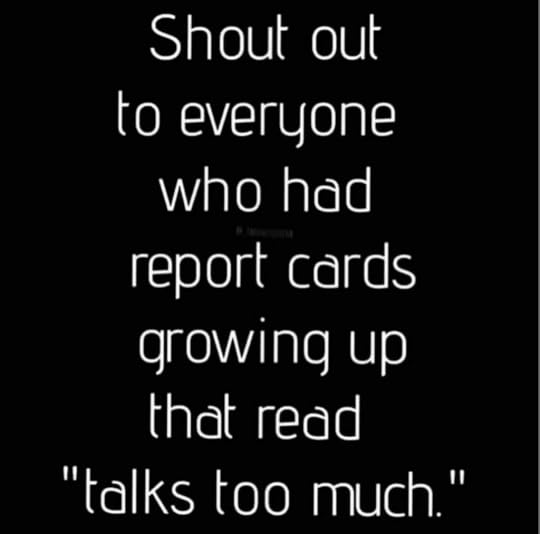
Blogs are fabulous for writers because we are WORD PEOPLE. They’re also wonderful for SEO in large part because there are so many SEO goodies we can pack all in one place. Google likes to see a number of crucial elements:
Posts that are rich in relevant keywordsImages that are optimizedOptimized videoAudio you’ve optimizedInternal links (links to other salient places on your site)Quality external links (links to outside pages with authority)Pingbacks (quality sites linking BACK to OUR page)All these factors (and more) entice search engines to list your content above the competition. Obviously, we’re unlikely to use/have ALL of these in one post, but we can use quite a few.
That and I can pretty much promise y’all that no one is ever going to do a random Google search and find our witty tweet, our clever Facebook post, or our shiny Instagram. They WILL, however, find our blogs.
People LIKE to share great blogs. This is true for writers and even businesses. Blogs can inspire, entertain, inform, or, like this blog…teach. My blogs might be long for a blog, but—trust me—they are REALLY short for the BOOKS one would have to read to learn all this stuff.
Great posts help us on social media. Though we won’t earn any SEO for someone tweeting our post, these endorsements act as signage directing strangers to our content. Then, once they’re on our site, we have our chance to win them over and make a fan.
I write FICTION. Why do I care about SEO or a BLOG?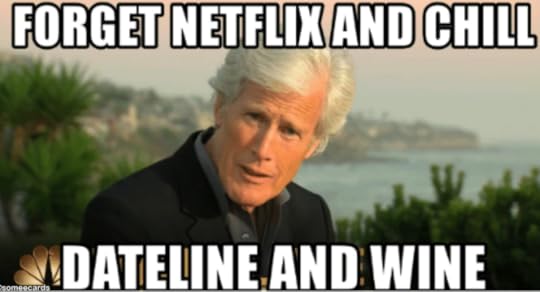
First of all, if you choose to blog, I STRONGLY recommend blogging off your own site so you get all the SEO credit. That and guess where you can SELL YOUR BOOKS? Um, your website. So YES, blogging is fabulous for novelists as well as NF (non-fiction) authors.
If I write mysteries, then what do you think my potential fans are interested in? True crime, forensics, famous unsolved cases, movies or series in that genre.
Or say I write science fiction. Again, what do people who LOVE science fiction also enjoy? We like to argue over Star Wars, who was the best captain in Star Trek. We enjoy stuff on science, futurism, androids, etc.
Profile your ideal audience for topics, then slap some SEO mojo on there. Trust me, after a day looking at spreadsheets, we are thrilled to argue about What Went Wrong with the Star Wars Prequels.
Sure beats book spam.
For more on specifically HOW to craft a fiction brand, I recommend my evergreen branding book, Rise of the Machines: Human Authors in a Digital World. There is a detailed step-by-step that will save YEARS of trial-and error.
Now that I’ve established blogs are a great idea for juicing up your SEO and your brand, how does it all…um, work?
Keywords, webcrawlers and SEO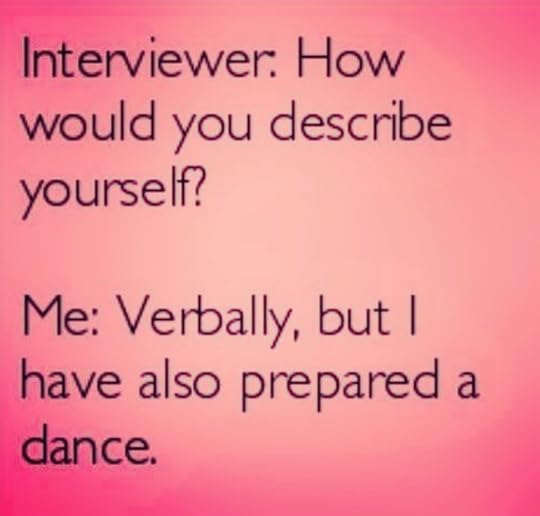
Keywords give search engines guidance as to what any piece of content is ABOUT. In my early days of blogging, I could use clever titles that hooked people to click and didn’t actually give away the topic. I still “can” but it’s better to cut to the chase and say IN THE TITLE what my post will address.
Years Ago: One Secret Ingredient to Work Smarter NOT Harder
Today: SEO—The Key to Working Smarter Not Harder
After search engines spot my keyword in the title, they then use webcrawlers to comb the page and sniff out certain cues this is a good path. If you notice, my first sentence uses the keyword I chose (SEO). Then, in the body of my first paragraphs, there are quite a few words that Google would associate with a post discussing search engine optimization.
The webcrawlers are in search of common synonyms or words one would expect like Google, Safari, Firefox, keywords, webcrawlers, etc.
They’re going to look at my H1, H2, and H3 level headers (think of an outline) to see if those headers also reference what I’m allegedly writing about.
While this might seem silly, think back to the early days of the Internet. I once looked up ‘Cuban Cuisine’ only to click and realize—to my horror—it was a p0rn site. There was A LOT of bait-and-switch before algorithms became ‘smart’ enough to sniff out the scam and refuse to list crap like that in a legit search.
What does it mean to ‘optimize’?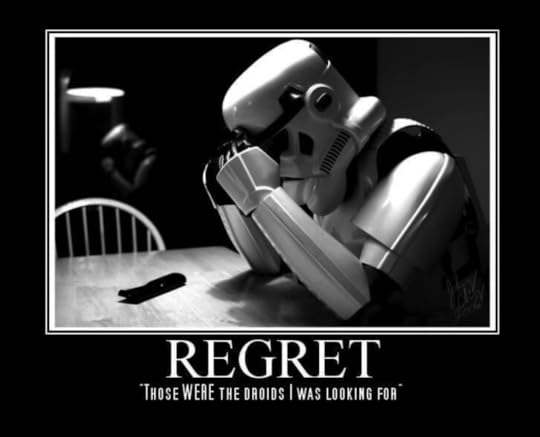
Optimization, to put as simply for the time we have, are all the bricks and breadcrumbs we leave connecting our content so search engines want to recommend us. We’ve left a really clear pathway, a better pathway than those with similar content.
I can put video or pictures on a post or a website, and it’s a great idea. The problem is that webcrawlers don’t ‘see’ the way humans see, so we need to help them out. One way is to add in ALT TEXT.
Most of us use the Visual Editor when working on a site like WordPress. But, if one looks to the Code Editor, you can see the ‘guts’ of the content (what search engines can read).
Here’s a screenshot of my dashboard and this is in the upper right-hand corner. At the bottom, notice I can select to see the actual CODE.

 The backend of the WordPress image.
The backend of the WordPress image.Notice how this block of code is bracketed with at the front end and closes with
THIS is what tells a webcrawler this is an IMAGE. It’s also beyond what most of us regular bloggers will mess with.
A professional could go change the actual code, but that is a bit much for today. Suffice to say, if I have an image with a woman using a computer, I need to either describe that in the ALT Text (woman on computer) or go in and modify the code. I can also add a title (Woman on Computer) to help the webcrawlers out.
***Note: An image of a woman on a computer is in line with images that make sense for a post about SEO.This works for video and audio as well. A search engine cannot SEE, so when we ‘optimize’ we are literally writing out WHAT that image or video IS and why it’s relevant to our topic.
IDEALLY…
In a perfect world, we’d use all our own images, video, etc. Granted, this isn’t the most expedient. Just know that if your images are uniquely yours (as in off your smart phone), you get more credit than an image from, say, a FREE use site like Pexels.
But, as I like to say, “Perfect is the enemy of the finished.” I’d rather y’all have ‘lesser images’ that help out your FANTASTIC blog post than a post with no images at all.
Keep in mind that many people are reading articles on phones. TINY font. That or they’ve been at a computer all day long. Their eyes are tired. Huge chunks of text are the equivalent of tossing their corneas into a digital iron maiden.
Adding in images can not only add a little SEO boost, but they can make posts more enjoyable and improve overall readability.
The Trick to Links
Links are wonderful for SEO. Visitors can easily spot the link. These are the clickable words in blue. These blue words are also known as anchor text. To make the best use of anchor text, make sure the words in blue clearly indicate where the link will take any visitor.
Example: This post gives us 10 Ways to Protect Your Personal Information.
Notice I wrote out the title of the post and it is SUPER CLEAR what anyone clicking will be reading about. No need to be clever, just be clear.
A few more key things to remember.Whenever you add in a link (anchor text), make sure to choose the option for the linked content to open in a NEW page. The goal is to offer additional insight without directing visitors off of our website.
Visitors might back up and try to relocate our site, but do we really want to risk it? That and search engines can ding us for that.
Also, it might be worth your time to go through your site and blogs and get rid of any dead links (links that no longer lead anywhere). A lot of this I need to do, but what’s the old saying? A cobbler’s wife never has new shoes.
I’ll get to it…one day.Then, we also want to offer internal links that expound on our topic but that don’t use the same keyword. For instance, earlier in this article, I linked to a previous post I wrote about blogs. Blogs are are part of SEO, but the post was not about SEO.
For my external link, I directed y’all to Pexels, which is one of my favorite sites for free images. Again, images are great for SEO, but the site is not about SEO.
This way my keyword is not directly competing with internal or external links that have the SAME keyword. Rather, they have related keywords.
As for pingbacks connecting back to ME? I have to earn those. If we post regular, high-quality content, odds are people will eventually link back to us. Remember, linking to quality outside sites helps their SEO, too.
Also, it doesn’t hurt to ask.
I know many of y’all blog and I give double points in my editing contest at the end for those of you who link to me in your posts. Not only does it help your SEO because my site is popular and trusted, but I’m offering an additional incentive in the form of a fun contest.
SEO is a LONG GAMEKeep in mind that search engine optimization really IS a long game. It will take time, trial and error to see results. Even after that? You’ll need to regularly tweak.
Of course there are all kinds of extra tools we can use to find the best keywords (Moz Keyword Explorer) and all sorts of high-end analytic tools to see how our site is performing.
I recommend adding the YOAST plug-in to help out. There’s a free version as well as a paid upgrade. This plug-in literally spells out all the stuff your post still needs. Headers funky? Yoast will nail you. Not enough external links? Again, Yoast will tell you. So if you’re a n00b at SEO, it’s a fab place to start.
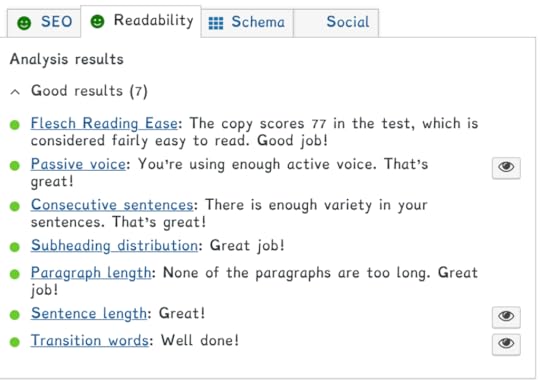 Yoast analysis of my writing.
Yoast analysis of my writing.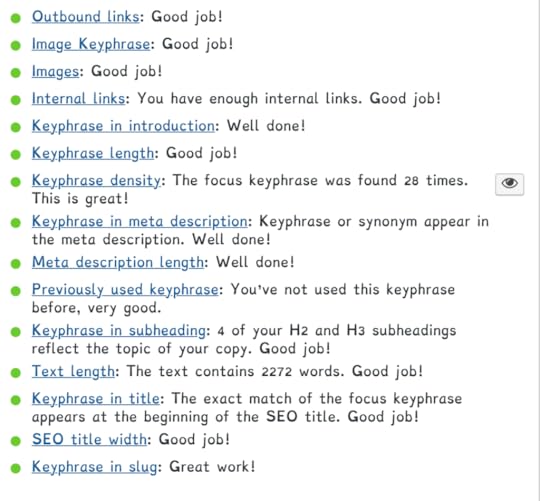 My Yoast SEO panel.
My Yoast SEO panel.Yoast also offers a ton of tutorials on YouTube from super-n00b to pro.
Just remember that small actions, over time, add up. It’s why we check in at certain key points over time. This will let us know if what we’re doing is working or if we need to adjust our approach.
Obviously there is a LOT more to this SEO thing, but knowing the basics goes a long way. This will help make sure that you can reap rewards from the hard work you put into your content.
We could have the spiffiest website or blog out there, but if we fail to create clear, well-lit paths to our content, then no one will know about it.
Thoughts? I LOVE hearing from you!I ‘get’ this is a super-newbie post and there are way more gizmos out there. Did this help those of you out there who maybe heard about SEO or search engine optimization but maybe you were intimidated?
I really hope this broad perspective helps with the fear factor and if y’all want me to go into greater depth on anything, let me know! Any questions? Comments? Funny limericks?
I love hearing from you!
What do you WIN? For the month of MARCH, for everyone who leaves a comment, I will put your name in a hat. If you comment and link back to my blog on your blog, you get your name in the hat twice.
What do you win?The unvarnished truth from yours truly. I will pick a winner once a month and it will be a critique of the first 20 pages of your novel, or your query letter, or your synopsis (5 pages or less).
***February’s winner is Barbara (a.k.a. bhussy)! Please send your pages double-spaced, Times New Roman, one-inch margins to kristen at wana intl dot com. Put CONTEST WINNER in the header so I SEE it, since I get a zillion emails. A page is 250 words. Feel free to go over a little if you need to finish a sentence or paragraph.
The post SEO: The Key to Working Smarter not Harder appeared first on Kristen Lamb.
March 10, 2022
Arc: How Characters Grow and Change Organically

Arc is critical in stories. How do the characters change? Who changes and how? What is an arc and do we need a protractor?
In my last post, Personality Traits: Creating Dimensional Characters, we talked about how useful personality tests can be for character creation and balancing the party.
Ideally, we want to have a nice mix of personalities that compliment each other. But, it’s also critical they all generate conflict lest we end up with a snooze-fest.
Stories offer an escape, provide entertainment, teach, and promote introspection and examination. Most importantly, stories expand on the human condition and show us change is possible.
For the record, feel free to skim this post for the highlights. I LOVE examples because that’s how I learn best, and I worked very hard to offer a wide variety of illustrations to demonstrate my points.
Moving on. People change, and…
This change is called arc, by the way. Jack drives Rose’s arc.
Jack drives Rose’s arc.Granted, there are some characters who never change but they remain the same for an important reason. They’ll act as the lever that forces those around them to arc.
Think Jack Dawson in Titanic or Captain Jack Sparrow in the Pirates of the Caribbean franchise (total coincidence I have two Jacks, for the record).
These characters introduce drama, adventure and chaos into the lives of those around them, people who probably never would have changed had they not crossed paths with one of the Jacks.
Rose would have dutifully married her betrothed Cal Hockley. She’d have lived within the rules, confines and expectations demanded of a lady of her station.
Blacksmith Will Turner, too, would have lived out his life the way social convention dictated. He’d have gone to his grave wondering what might have been. His secret love—the governor’s daughter—would have forever remained that…a secret.
It is only when bad men kidnap Elizabeth Swann and Captain Jack Sparrow subsequently crashes into Will Turner’s life that everything changes.
Mach-IV and Belief
Last time, I introduced the Mach-IV test. The Mach-IV test measures how Machiavellian a person is. High-Mach people tend to be very practical, cynical, ruthless, and highly analytical (they also get a bad rap as all being heartless sociopaths, which is grossly inaccurate).
Low-Mach people generally are more emotional, tend to see the world with rose-colored glasses, believe in the benefit of the doubt and the inherent good of humanity (but they can also be naive and easily duped).
Unlike other personality tests like Meyers-Brigg or the Enneagram test, the Mach-IV changes.I was an ENFP/INFP in high school, college and today (I score dead even on introvert/extrovert so it is a toss-up). Time, experience, victories and defeats have had little impact on my core personality.
But the Mach-IV is different. It measures how a person sees the world. So say a person generally believes humans are good. They feel honesty is the best policy. They’d NEVER flatter someone in power to manipulate a result.
Nothing wrong with that.
Now toss this person into an unexpected war (or other massive crisis). The person who’d never lie, cheat, steal or manipulate before the life-altering event suddenly has to make some tough choices. Survival is on the line.
Those Who Can’t and Those Who Can
There are those who can change (arc) and those who can’t. These static characters are great for generating tension, but they need to either be limited or offset by more reasonable characters.
Some people, when crisis hits, don’t, can’t or won’t change. Often these people die. At the least, they can put everyone around them in danger.
Depending on your story, the person who refuses to compromise can be an incredible source of tension. This character can exist on either extreme of the Mach-IV spectrum.
Think of a band of refugees running from an invasion who are trapped with the person who cannot ever tell a lie.
Fellow D&D nerds? This is Lawful Good.Either they can’t lie (some people can’t, which is why they suck at poker) Or, they won’t. Maybe they have strong moral or religious convictions.
If your band of heroes decides to take this person into their party, then they are automatically handicapped. They’re going to have to make sure they can run interference. For instance, if this pathologically honest person is questioned at a checkpoint, everyone could die.
If it would serve the group to sneak up on a guard and stab them in the back, the other characters (Iron Man) will likely have to distract or offset our White Knight who’d never abide by this behavior (Captain America).

A rigid moral compass does little to help expedience.
See, there is nothing wrong with this noble character if used, or offset properly.
We can flip the script and have a super High-Mach person who acts on their impulses. This character believes the ends justify the means and can be extremely chaotic. It’s also hard to trust this person even if they’re very effective. This is when the Low-Mach (Captain America) can offset the chaos of the High-Mach (Tony Stark).
Arc: Changing a Low-Mach into High-Mach
So, if you look at our Low-Mach and our High-Mach, they make for great static characters who can drive change in those around them.
Just note, High-Machs and Low-Machs CAN CHANGE (and it’s really fun to watch them transform).
We can arc a Low-Mach into a High-Mach. Think Sarah Connor in the Terminator franchise. She goes from being a simple waitress who believes what she sees into a one-woman killing machine.
In the beginning, her world is a normal, boring routine. Likely her days are much the same…until a man from the future careers into her life to protect her from a murderous cyborg.
Sarah MUST change if she a) hopes to survive b) hopes to protect her unborn son c) hopes to save the world.
Sarah Connor is a fascinating study in that she arcs from being about as Low-Mach as one can get into a metaphorical representation of the very machine she’s sacrificed everything to destroy.
Think of how Reese explains the terminator:
Listen, and understand. That terminator is out there. It can’t be bargained with. It can’t be reasoned with. It doesn’t feel pity, or remorse, or fear. And it absolutely will not stop, ever, until you are dead.
Kyle Reese in “The Terminator”
This is Reese’s description of the cyborg in Terminator. BUT, how much does this LATER describe Sarah Connor in the sequel, Terminator 2?
Low-Mach to High-Mach an Easier Sell
I believe it is actually easier to arc a Low-Mach to High because that is a character most people will feel comfortable with in the beginning.
Since most people fall in the Low-Mach or at least the middle of the range and VERY FEW score as High-Mach, this character is an easier sell.
Why? They look like and think like most people, so it’s easier to get the audience to like them and empathize. Sarah Connor would have never become so iconic had we met her in her 2.0 version. A naive, struggling waitress is a better place to begin.
Other great examples? Buffy in Buffy the Vampire Slayer, the group of regular teenagers in Red Dawn, and love interest Dana Cummings in The Accountant.
What about the opposite? High-Mach to Low-Mach? Image via “As Good as It Gets”
Image via “As Good as It Gets”I don’t believe it’s possible to have the extreme changes going COMPLETELY the opposite direction. It’s much more reasonable for a naive goody-goody to turn very dark than it is to turn someone very dark into a total goody-goody.
Not impossible, merely easier.
One is believable, the other requires either something akin to a Road to Damascus experience, or a trial by fire brutal enough to soften even their hard hearts.
For instance, Road to Damascus moments happen. We have Scrooge in A Christmas Carol. His life might not be on the line, but his salvation is.
What about a former drug dealer who nearly dies after being shot, who then becomes a street minister? A notorious cyber-criminal who changes sides and uses his knowledge to fight bad guys like HE once was? Maybe a hardened prostitute who stumbles across an abandoned baby and it changes her life?
Get CREATIVE!
Don’t have a near-death-revelation to work with? No problem. We ALSO have the massive trial by fire. Life just turns on the heat until the High-Mach softens up.
High-Mach people just aren’t going to suddenly believe the world is all essentially good and see only kittens and unicorns.While we cannot completely change a them, we can chill them out. We can make them at least a Lower-Mach.
Sherlock (the BBC version) is a good example I introduced last time. By adding in foils like Watson, Lestrade and Molly, Sherlock Holmes arcs and evolves over time into a kinder, gentler prickly pear.
In the beginning, he is solitary, friendless and acerbic to the point of being his own worst enemy.
By the end of the series, he is still Sherlock, but without all the hard edges and points. He’s no longer alone, experiences a semblance of love, and has emotional attachments with the very people who loathed him in the beginning.
He’s even willing to die for them.
While I feel this is tougher arc to write well, if we pull it off, it makes for some of the most timeless stories.
Examples
One of my favorite examples of a High-Mach to Lower-Mach? Gran Torino. Walt Kowalski is an angry, racist Korean veteran who’s transformed when he stands up for his Hmong neighbor against a local gang…the same neighbor who tried to steal his beloved car.
Kowalski is a miserable human being, but when he chooses to try and reform the teen, Thao, he gets more than he bargained for.
By getting involved with his Korean neighbors, he comes to grips with the pain and loss that’s been driving his racist attitude. He becomes a better person.
Walter serves as a surrogate father to Thao who’s heading down a path that leads only to prison or death. Thao, in turn, transforms Walt’s heart of stone and restores his humanity.
Another fab example? Melvin Udall, the misanthropic romance author in As Good as It Gets. Udall is a miserable jerk who suffers from debilitating OCD. He has no use for humans and, frankly, they have almost no use for him.
It is only when Melvin’s gay neighbor is the victim of a hate crime that we see Melvin begin to defrost. Between that and his relationship with his favorite waitress and her son, Melvin transitions from utterly irredeemable person to someone we eagerly root for by the end.
The Trick to High-Machs Melvin Udall in “As Good as It Gets”
Melvin Udall in “As Good as It Gets”As I mentioned earlier, High-Machs can be a tougher sell. We have to hook the reader early and hook hard. If our character is too off-putting, then that is no good.
We can do something that humanizes an otherwise unsympathetic character.
With Marvin Udall, the writers humanized him by showing his paralyzing OCD and the impact it had on everyday life. Yes, Udall is a b@stard, but when his world doesn’t perfectly line up? He’s a lost, frightened child.
What better way to SHOW (not tell) Melvin’s arc—how he has CHANGED—than have him curled up with his neighbor’s dog, the same dog he tossed down the garbage shoot in the beginning of the movie?
We can also use supporting characters to keep the audience vested long enough to start caring for our High-Mach character. This is evident in A Christmas Carol—we care about Bob Cratchit even if we have no use for Scrooge.
Save the CatWhy do audiences love to see High-Machs arc to Low(er)-Machs? We all want to believe in redemption.
We can also inject what the late, great screenwriter Blake Snyder referred to as a “Save the Cat” moment. Christian Wolff, the CPA/hitman in The Accountant is, on the surface, like trying to relate to a robot.
 Image via “The Accountant.”
Image via “The Accountant.”Not only is Christian’s backstory brilliantly woven throughout the movie, but in the VERY BEGINNING we see him helping an aging couple with their taxes.
He uses his supercomputer brain-powers to navigate tax law and make sure the couple doesn’t lose their farm to the IRS. While not evident in any of his body language, we sense he really does care. Soon after this event, Christian literally saves their lives when bad guys come calling.
***Note how his NAME shows what a contradiction he is—Christian Wolff.
How to Arc a Low-Mach to a High-Mach Walter White in the beginning. Image via “Breaking Bad.”
Walter White in the beginning. Image via “Breaking Bad.”While this might seem easier to do, we still have to tread carefully. First of all, we need an event or a situation robust enough to fundamentally alter our Pollyanna’s world view. Obviously, war, disaster, famine, etc. are all doable, but there’s no need to be myopic.
Catastrophes that are personal can actually resonate better. Why? Because most people are far more likely to face down cancer than an asteroid hurtling toward Earth.
Why do audiences love to arc Low-Machs to High-Machs? We like to believe in humanity’s capacity to survive no matter the odds. It’s also a solid reminder to be careful how we judge.
We honestly do NOT know how we’d react in any given situation, and these stories and characters keep us humble.
Never say never. Image via “Breaking Bad”
Image via “Breaking Bad”This is why the series Breaking Bad has been so popular. Walter White is a high school chemistry teacher. His son has cerebral palsy. When Walker is diagnosed with Stage III cancer, what does he have to lose?
He uses what he knows best—chemistry—to provide for his family after he’s dead.
Now, do y’all think Walter just woke up one day and thought, “Hmmm, I think I’ll become a drug kingpin”? Of course not. But the sudden deadline—emphasis on DEAD—is enough for Walter to throw away his moral inhibitions for what he sees as the greater good.
Why is this story so fascinating? Because it forces self-examination. We honestly cannot answer if we’d do any better if faced with the similar life-altering events. Stories like these engender self-examination.
Who do we believe we are versus who are we…really?
The trick to arcing a Low-Mach to a High-Mach is the reason must be big enough for the audience to give them a pass. It needs to hit us in our tender parts hard enough to at least rattle our resolve.
Pacing Character Arc Doctor Strange hitting rock bottom.
Doctor Strange hitting rock bottom.Sure, I suppose it is possible for someone to instantly change, but that is a tough sell. If we look at Scrooge, the entire point of the three ghosts visiting is to soften Scrooge enough so the audience not only wants redemption, but they also BUY his redemption.
Same in the movie Doctor Strange. Hot-shot surgeon Dr. Stephen Strange is the best in the world at what he does…and he knows it.
He’s a hopeless narcissistic jerk.
In fact, his narcissism is what causes the accident that destroys his hands and effectively takes away his superpower. Losing his status is the only thing that can humble him enough to seek help that isn’t based in science.
He must reach out to those he once mocked. But it isn’t easy. Strange doesn’t show up Day One at the temple in Nepal and the monks instantly agree to make him whole (or actually better than whole). Strange remains a skeptic (and a jerk) for much of the movie.
That is, until he arcs.
Granted, he’ll always be an egomaniac, but he finds a purpose that is greater than simply serving himself. He ego is channeled to service above self.
Arc & Kubler-Ross Stages of Grief Image via “Doctor Strange”
Image via “Doctor Strange”Character arc also needs to happen organically. Often the change will follow the Kubler-Ross stages of Death and Dying: denial, anger, bargaining, depression, acceptance.
The stages don’t need to neatly go down the line. In fact it is highly common for someone to make progress only to suddenly regress. They might seem to reach acceptance only to go back to bargaining.
By using these stages our character’s arc will feel more authentic. Few people are hit with a life-altering event and jump all the way to acceptance. That just doesn’t happen or happens so rarely the audience won’t buy it.
Denial: This isn’t real. Stuff like this doesn’t happen. This can’t happen to ME.
Anger: What did I do to deserve this? This isn’t fair. How can you expect me to do X?
Bargaining: Okay, things are bad, but there has to be another way.
Depression: How did I get here? Will I ever be the same? Who am I?
Acceptance: Gotta do what you gotta do. I need to change.
I guarantee if you look at your favorite movies, you’ll see this pattern. It might even be subtle, and generally is best if it is lest it come across as stilted or preachy.
Mach-IV and Romantic Arc Sherlock Holmes and Molly Cooler via BBC’s “Sherlock”
Sherlock Holmes and Molly Cooler via BBC’s “Sherlock”One of the commenters (Barbara) asked an excellent question about the Mach-IV scores in the last post. She wanted to know if/how it could be used in a romance. Hopefully, by now, y’all can see how the Mach-IV scale is used in all genres, but romance probably already applies it quite liberally.
How many Hallmark movies revolve around the sweet, sensitive handyman melting the heart of a no-nonsense corporate lawyer and reminding her of the true meaning of puppies, Christmas, then finally love? Or the scatter-brained but tenderhearted nanny who shows the hard-nosed diplomat it is okay to love again after losing his wife?
How many staple romance characters are deeply wounded? They’ve vowed to never love again. They refuse to ever be vulnerable again. Maybe they have a dangerous job or shady past and so they keep everyone at a distance.
Perhaps one of them is seemingly ‘incapable’ of love. In fact, emotionally unavailable men have been a staple of romantic characters since Mr. Darcy at least.
Why do y’all think I have been crushing on Sherlock?
There is a whole canon of fanfic (Sherlolly) devoted to Molly Hooper and the emotionally handicapped Sherlock Holmes finding love together.
Personal vows are a big deal in romance.Though I don’t want to be overly reductive because romance is a vastly complex genre, the whole POINT of romance is a) opposites attract and b) showing love wins. If there were no barrier to love in the beginning, then we have no story.
The larger the barrier, the more insurmountable the odds, the better the story.
Obviously the two partners are going to have to alter their worldview if they hope to find love. In romance, the love interests are going to have to arc and meet somewhere in the middle if they hope to find their HEA (Happily-Ever-After) or the more contemporary HFN (Happily-For-Now).
What Are Your Thoughts?Enjoy your Spring Break for those who have that right now. Do you now understand what arc is and how to do it well? At least a little better? Who can add examples from film, television or movies?
What are your favorite High or Low-Mach characters? Do you prefer resilience stories or redemption stories? Or do you love both?
So again, any thoughts, questions, opinions? I do love hearing from you.
What do you WIN? For the month of MARCH, for everyone who leaves a comment, I will put your name in a hat. If you comment and link back to my blog on your blog, you get your name in the hat twice.
What do you win?The unvarnished truth from yours truly. I will pick a winner once a month and it will be a critique of the first 20 pages of your novel, or your query letter, or your synopsis (5 pages or less).
***I will announce previous winners next post and will have new classes available soon. Still getting over COVID so getting there, slowly but surely.
The post Arc: How Characters Grow and Change Organically appeared first on Kristen Lamb.
March 4, 2022
Personality Traits: Creating Dimensional Characters

Personality traits make for not only a fascinating study, but have continued to be at the heart of spirited debate since probably the dawn of time. What makes up our personality? Where does it come from? Is it malleable? What forms our personalities? Nature, nurture or both?
***Apologies for the delay between blogs. Hubby and I both caught COVID at the same time and it turned into pneumonia. We’ve been sick so long I am pretty sure my son (Spawn) was on the verge of going feral by the time I had enough strength to actually cook a meal instead of leaving him to forage.
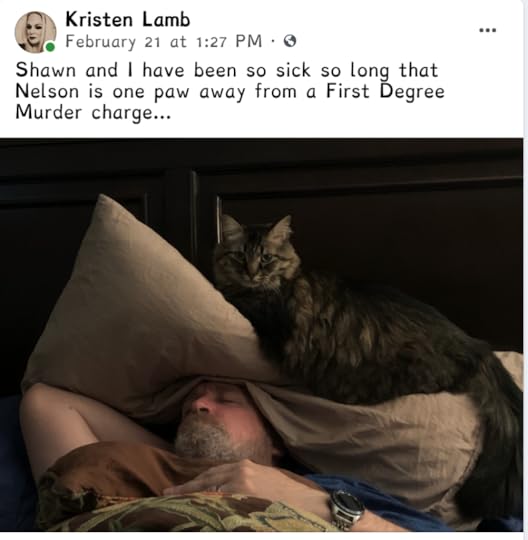
Anyway….
I am one of the worst people in the world to get sick—that ‘personality’ thing. It takes forever for me to recover because of my pathological guilt that I am not cleaning, cooking, working, and doing all the things I normally do to take care of others.
I’ll get to taking care of myself one day…one day.
As I have ‘joked’ about previously, I am not Type A, I am Type A+ because I actually took time to do the extra credit. This, among other recent events, got me thinking about personality.
During my tenure of staying in bed (and praying for death), I watched a lot of television. I don’t watch television like normal people, because I am still working. I’m breaking down structure, making notes, paying attention to dialogue, etc.
Why do I mention this?
Because we happened to watch an episode of Bull where they mentioned the Mach-IV test.
Personality Confessions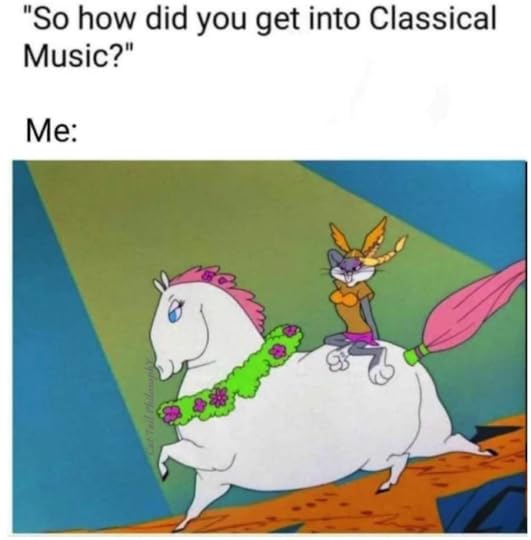
I don’t know about y’all but I love personality tests. From the Myers-Brigg (dead split between INFP and ENFP) to the Enneagram (a 2, ‘The Helper’ or an 8, ‘The Challenger’ depending on the day), I’m captivated when it comes to learning more about myself and others.
Yes, I am one to pester friends and loved ones to take a personality quiz. I find it so interesting to see not only why and where we connect but to also see why and how we fail to understand one another.
For instance, my personality is comfortable with making decisions off gut instinct and intuition….which is a great way to make my husband break out in hives. By understanding how his personality differs from mine, I know that if there is a big decision to be made, ideally I’ll present him with charts, graphs and articles.
Back to the Mach-IV test.
How Machiavellian Am I?
As I mentioned, Hubby and I were both sick and watching the show Bull. Bull is a trial scientist and his specialty is choosing the best jury for the best outcome. In every show, he psychologically profiles his ideal jury pool. In this particular episode, he needed a jury of people who would be sympathetic to a person breaking the rules for the right reasons.
Niccolò Machiavelli was a Renaissance political philosopher who’s responsible for the phrase, “The ends justify the means.”
Obviously, this T.V. episode is where I learned about the Mach-IV test, and, because we weren’t doing much of anything else, Hubby and I both took the test.
My results? Um…let’s just say that Uncle Nicky would be very, very proud.
Yet, after taking the test—which might lead one to believe I am a functioning sociopath—it really threw me for a loop. Why? Because, if anything, I am the antithesis of what this ‘personality test’ claims I should be.
Being the Queen of Overthinking I wondered how this could be. Then I thought about the test. All it scores is what I believe to be true. There is no allowance for how I then filter that information through my moral matrix and then translate this into how I then ACT.
Taken at face value, one could (as I mentioned) believe this test shows I am a functioning sociopath. But, viewed another way, it can also mean that I am very jaded about the human condition and that is why I often overcorrect.
What Do I BELIEVE? Not everything a direct translation…
Not everything a direct translation…If you go take the Mach-IV test you could probably end up with vastly different scores depending on how you approach your answers. They give a fairly broad scale for answering from ‘Strongly Agree’ to ‘Moderately Agree’ all the way down the line.
Whenever I take tests I make it a point to avoid overthinking. I also rarely hedge my answers. Ironically, that is how I am in person. I generally will ‘Strongly Agree’ or ‘Strongly Disagree’ on pretty much everything (unless I know nothing about the topic). So these two factors alone probably impacted my score.
When I get a ‘question’ like: Honesty is the best policy all the time.
Are you NUTS? NO! If I were in wartime Germany hiding Anne Frank in my attic and the Nazis stopped by? Trust me, I would have been lying my tail off.
But look at the wording of the question. It states honesty is best all the time. Just because I believe that honesty all the time is a stupid policy doesn’t mean, by default, I believe in dishonesty as my go-to policy.
Long story short, I believe the test revealed more cynicism than psychopathy.
Personality & the Moral Matrix I have my days…
I have my days…And obviously, this is what started my overthinking. I was rather horrified when I saw all the articles and blogs about how those with high scores were natural con artists, bad company, opportunists and horrible human beings in general.
Just because I strongly agree that “It is wise to flatter important people” doesn’t mean I am wise. In fact, I’ve lost count of how many ‘opportunities’ I’ve missed out on simply because I flatly refused to “flatter important people.” Would it have been wise? Sure.
But I’ve had a lifelong habit of being very, very ‘unwise.’I don’t want any advantage or benefit that I cannot earn honestly. In fact, not too long ago I even blogged about turning down the chance to make a LOT of fast cash and ‘earn’ the title of USA TODAY BEST SELLING AUTHOR in front of my name. Why? Because the whole plan seemed shadier than a guy in a panel van giving away Rolex watches in Gucci handbags with the purchase of a pound of ground beef.
I blogged for almost a year shaming the whole FREE and exposure dollar BS. Would it have probably been wise for me to flatter the likes of Arianna Huffington? Probably. I sure would have been called the ‘c’ word a lot less (‘caring’ NOT that word).
My point in all of this being that two people can have the exact same ‘personality’ yet be different in every way. We all have a moral matrix, a filter that impacts how what we believe, that then translates into our actions and behavior.
Which is probably why personality tests are so interesting. What I didn’t really like about the Mach-IV test is every other ‘personality’ test accounts for the good and the bad. The Myers-Brigg gives a profile of what each personality type ‘looks like’ when they are healthy versus when they are ‘out of whack.’ Same with the Enneagram and most other personality tests I have seen.
Apparently the Mach-IV test doesn’t believe there is such thing as a healthy cynic, which brings me to my point about character creation….
Personality and Characters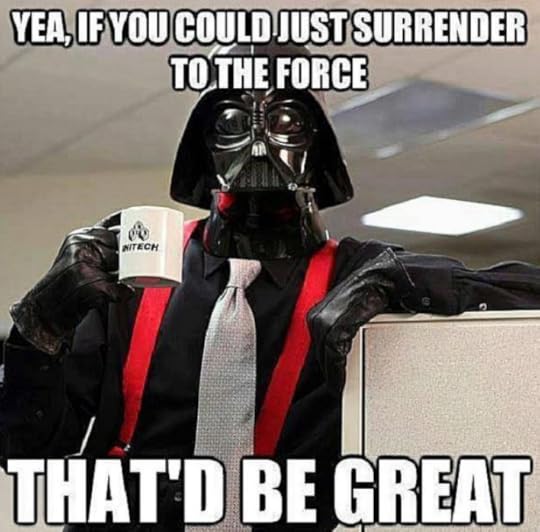
The other personality tests I have taken didn’t throw me into a tailspin of self-evaluation, in large part because most of them aren’t so black-and-white. High Mach-IV score = con artist psychopath and low Mach-IV score = good and kind human.
But let’s take the idea of the Mach-IV test and look at how we can apply this to character creation.
Often the antagonist is the shadow side of the protagonist. The villain is the shadow self of the hero. Ironically, this duality and mirroring is what a) makes for fantastic conflict b) drives the protagonist to arc and change and c) keeps the antagonist (usually a villain) at a disadvantage.
I caveat that last point for a reason. First, not all antagonists are villains (check out my blog on the Big Boss Troublemaker) and usually villains do not arc. This is what, ultimately makes them weak enough to be defeated by a fully self-actualized protagonist.
Obviously most people don’t score high on the Mach-IV test. They give a bell curve of how most people score at the end, but the best fiction usually operates in extremes, characters included.
In fact, two of the most famous characters in literature probably would have had identical scores.
Sherlock Holmes & Professor James Moriarty
From the original Sir Arthur Conan Doyle series to the BBC series with Benedict Cumberbatch (my favorite), the famous consulting detective regularly crosses swords with his mirror twin and consulting criminal, Professor James Moriarty.
Ironically, the very quality that makes Sherlock ideal to hunt down Moriarty is the quality they most share. They are both high-functioning sociopaths. Sherlock is willing to lie, manipulate and break every rule to attain his desired result. Like Moriarty, he believes the ends justify the means.
Unlike Moriarty, however, Sherlock is bound by a strong moral compass. There are some lines he won’t cross…which is what places him, ON HIS OWN, at distinct a disadvantage when going against his arch nemesis.
But we can’t have Sherlock too perfect. What makes him an excellent consulting detective also makes him struggle when it comes to interpersonal skills.
***I’ve read the originals and Sherlock was actually ‘too perfect’ of a character. He was much kinder and nobler than one could pull off with a modern audience. I believe contemporary versions of Sherlock have actually played up the ‘high-functioning sociopath’ angle much more than the original stories to make him more flawed.
Balance the Party Image via “Sherlock Holmes” BBC version and MY FAVORITE!
Image via “Sherlock Holmes” BBC version and MY FAVORITE!If I just stated that Sherlock—by virtue of having a moral compass—is automatically placed at an inherent disadvantage when pitted against the cold-blooded Moriarty, then how can Sherlock ever hope to win?
Sherlock has a level of self-awareness Moriarty will never possess. While the great detective knows he has almost no intellectual equal, he also appreciates he can’t rely on brain-power alone.
There is more required if he wants wants to win the war, not just the battles. Sherlock has the ability to set his ego aside, recognize potential deficiencies, then use those around him as a bulwark.
This is why Dr. Watson makes such a terrific foil.Sherlock understands his lack of compassion—which translates into terrible people skills—can be a hinderance. This is why Watson acts as a) a sort of angel on his shoulder to whisper in his ear and b) someone to smooth ruffled feathers after Sherlock has trampled all over their feelings.
The same might be said of Detective Lestrade. Lestrade frequently serves as an interface between Sherlock and the public and the legal system. He also runs interference when Sherlock is his own worst enemy.
Conversely, Moriarty revels in his superiority and is only content to be a puppet master. Lacking even a modicum of self-awareness cannot help but eventually weaken any advantage he might gain simply by being the ‘most ruthless.’
Personality & Conflict Or punctuation and conflict.
Or punctuation and conflict.Conflict is what turns pages. It is also what turns a reader into a super fan. We, as writers, no longer have the luxury of taking our sweet time to hook a reader then never let them go.
Conflict is more than just ‘bad things happening.’ If we want to keep our readers up until three in the morning—simultaneously hating and loving us—we need to maintain constant tension.
Obviously, we have to pace this or it will wear the reader out. Think bad action movie.
Another car chase?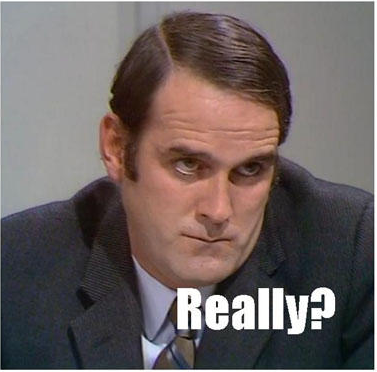
Yet, bookmarks = DEATH. Ideally, we will leave no ‘good spot’ to stop reading. One of the best ways to inject tension we can easily ramp up or taper off is in the interpersonal realm.
How do the characters’ personalities compliment/clash? This is how we can create tension on multiple levels.
As we see with Sherlock and Dr. Watson, they are polar opposites. While both have admiration/respect for one another, they clash all the time with each other as well as with other characters within their orbit.
Sherlock stampedes over the feelings of key witnesses and Watson has to step in to do damage control. Or, Watson loses his cool and costs them vital evidence/time. Sherlock then has to up his game to make up for his friend’s rashness.
Use the Science & Study Personality
Early on, I mentioned a couple of the most popular personality tests. When you are crafting characters, try using these tests. What are the personality types most likely to get under their skin and why? How do they make a character stronger or weaker? In what ways do they ‘push each other’s buttons’?
As I mentioned in the beginning, I am an ENFP. I’m extremely comfortable making snap decisions without fifty pages of research, but that is why two of my closest friends are INTJs.
I ALREADY KNOW Grace and Cait are going to do the fifty pages of research on every bit of minutiae, so when I need information quick? I call them. They’re wonderful treasure troves of go-to data.
Sometimes, they need to make snap judgements with little prep. Who do they call? Me.
Our differences are also where we most clash.I might want to get to writing something instantly, but Cait makes me wait for her to go do all the research and fit all the pieces together. It makes me bananas because I am a GO GIRL. Yet, ultimately she saves me a TON of time and mistakes by so heavily front-loading what we do.
When it comes to the Mach-IV test, one of my closest friends Beth scored as a low-Mach. We balance each other out fantastically. When I am too dour? I know I can call her and she will buoy my spirits and remind me why I love helping people so much.
Conversely, when she has a new and shiny idea, I’m the one to make sure she takes into consideration legal and market considerations to protect all her hard work. I often worry I’m being a Debbie Downer, but I care enough to warn her about potential risks before she’s too vested.
In the EndRemember that most great stories ignite in the extremes. A MAJOR issue I see with new authors is they frequently don’t go extreme enough to capture interest. Yet, we also have to balance out these extreme characters because what makes them great, can also undo them (again, think Sherlock). They very often are their own worst enemies.
Make sure to check for any character redundancies. That is another problem I see in new or weak writing. Often there are two or more ‘meh’ characters that could be combined into a singular personality that would be far stronger.
What Are Your Thoughts?I LOVE hearing from you! Do you enjoy personality tests? Have you found them to be fairly accurate? Are they a good way of seeing your strengths while also diagnosing your weaknesses?
Do you see how this might be a useful tool for creating characters? I often find characters in film and literature when I am crafting something for fiction, then cast from there. Why reinvent the wheel? The wheel works. If we study the books, films, show that had us biting our nails unable to stop, then they might be at least worth studying and using a similar template.
What are some of your favorite duos or casts where the differences in personality made the story come alive? From Deadwood to Ozark to The Office to Buffy the Vampire Slayer I can think of many great casts to work from.
So again, any thoughts, questions, opinions? I do love hearing from you.
What do you WIN? For the month of MARCH, for everyone who leaves a comment, I will put your name in a hat. If you comment and link back to my blog on your blog, you get your name in the hat twice.
What do you win?The unvarnished truth from yours truly. I will pick a winner once a month and it will be a critique of the first 20 pages of your novel, or your query letter, or your synopsis (5 pages or less).
***I will announce previous winners next post and will have new classes available soon.
The post Personality Traits: Creating Dimensional Characters appeared first on Kristen Lamb.
January 21, 2022
Branding & Attention: Busy Brains in a Busy World

Branding, at least for authors, is a relatively new concept. Selling books was SO much ‘easier’ before the digital age, when life ran at a comparable snail-hooked-on-Valium pace. Or it at least seems that way.
If you need to remove those rose-tinted nostalgia glasses, I do recommend reading my post The Ugly Truth of Publishing & How BEST to Support Writers.
Back to reality.
Now, in 2021, when people are busier and more distracted than ever before in history, branding is harder than ever before. The competition is staggering. Additionally, we have about a nanosecond to capture attention then not much longer than that to keep it.
Turning an impression into a sale? Then into a loyal fan? Even taller order. What color would you like that unicorn?I know it feels that way, but I am here to make it simple and DOABLE.
Today, the words ‘brand’ and ‘branding’ seem to be tossed around daily. Everyone and everything is or has or needs a brand. What’s funny is that branding might seem relatively new, yet has been around since…people.
Granted how important a brand is, the need for one as an author, etc. is a fairly recent development as I mentioned a moment ago. Yes, we need to craft excellent books (product) but we also must begin building our author brand EARLY.
***As in the first day we believe we might one day want to sell a book.
Ah, but calm down. There’s a lot of confusion regarding what a brand actually is. Many assume ads, marketing, and promotional campaigns are ‘branding.’
Yeah…no.
We can build a brand, but alas we cannot buy one. There are no shortcuts. Ads, promotion, marketing can help expand an existing brand, but cannot be substituted for one.
This approach is akin to believing a Japanese robot-wife is the same as a real human wife. In some areas of life, shortcuts end up a) a waste of time b) a bigger waste of money c) a remake of Blade Runner.
Branding Basics
As I mentioned in my last post, The Psychology of Selling, I wrote my book Rise of the Machines—Human Authors in a Digital World to be evergreen information. In my POV, social media changes daily, but humans never change.
Just read Shakespeare or look at your ex’s Instagram *rolls eyes*.
That’s why my social media/branding guide focuses a lot more on the science behind what creates what we recognize as a brand.
More specifically, what captures our attention? What turns us off? What renders a brand invisible (thus a non-brand)? Which habits/behaviors can ruin a powerhouse brand that once seemed bulletproof?
How can one brand launch into the stratosphere with little to no budget when another fails miserably no matter how many millions of dollars are poured into ad campaigns and celebrity endorsements?
Obviously, my book delves into far more detail about the science behind branding. But a little common sense goes a long way, and helps us work smarter not harder.
Thus, today we’ll simply touch on why our everyday on-line behaviors collect into a larger pool we call ‘author brand.’
First…
Branding is NOT New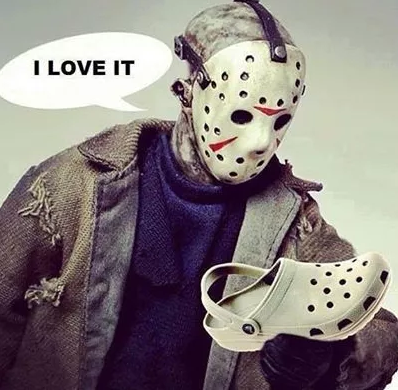
The thing is, humans have always had a ‘personal brand.’ Branding, in its simplest form, is what descriptors we attach to another person. Simply put, it is that person’s (that product’s or that company’s) story.
Think differently.
Just do it.
You’re in good hands.
‘Branding’ an innate habit we use to organize and transition the fuzzy and inchoate into the dramatic, emotional, and memorable.
Branding is simply an extension of story.
That guy/that gal is too amorphous for us to remember. It also doesn’t provide enough detail for us to know how we should respond.
But, ‘That guy who’s been married four times, loves hunting, and collects sports cars’ provides a narrative (a story) that will either resonate or repel depending on the audience.
Humans dig labels, now more than ever before. It’s how we make our increasingly larger world somewhat manageable.
Thus, people we ‘know’ are frequently tethered to a variety of descriptors—vegan, sports enthusiast, triathlete, cat lady, Cowboys fan, craftsy person, the comedian, etc.
There’s the perfect, put-together Pinterest moms and then there’s me….

This, in a nutshell, is ‘branding.’ Humans have been doing this ‘branding’ thing since the dawn of time. The only difference in a ‘personal brand’ and an ‘author brand’ is that the ‘author brand’ should eventually drive book sales.
Also, branding is now more vital than ever before because of the sheer volume of information, people, choices, etc.
This is why author brands are essential, since a brand is basically a beacon drawing people (readers) to something they find familiar and that they already know they like.
Here is where science comes in handy.
The Neurological Shortcut
Our brains are remarkable organs that have the ability to adapt to our environment. Before the invention of the written word, our memory centers were far larger because we had to pass down information orally.
In fact, if you took an fMRI reading of a tribesman from some isolated Amazonian tribe, his brain would look and act very differently from yours or mine.
With the advent of the written word, our memory centers shrank but we gained even larger areas for abstract thinking. This was around the time we start seeing major explosions in science and engineering.
#PyramidsAndLotsOfCatPictures
Now we’re in the Digital Age, and we’re bombarded with stimuli. Internet, television, radio, smart phones, podcasts, pop-ups, etc. etc.
We’ve traded our stellar memory centers and our ability to focus for long periods of time for the unprecedented ability to sift through and ‘judge’ vast numbers of data points almost instantly.
Our brains must process, then sort, save and discard massive amounts of information faster than ever before.
Think about it. We see ads on Facebook all the time. Or do we? Our brains have literally learned to un-see. We cannot manage all the input.
So, if we (authors) are eventually going to advertise our books, how do we make our content visible?
Branding with Intention
Since our brain is much like a computer processor, it must come up with ways to effectively manage all this input in order to maintain efficiency. To do this, it relies on what are called somatic markers.
Somatic markers are neurological shortcuts and are one of the most primitive functions of the brain because they are uniquely tied to survival and procreation. It’s the same shortcut that tells us the stove is hot.
We don’t need to sit and ponder the stove. We likely learned when we were very small not to touch.
To give you an idea of how somatic markers work, let’s do a little exercise. Is there a perfume or cologne you can smell and it instantly transports you back in time?
Maybe to that first love or even *cringes* that first heartbreak? A song that makes you cry?
Perhaps there is a food you once ate that made you sick and even though there is no logical reason you shouldn’t eat it now, the mere thought of eating it makes you queasy.
These are somatic markers. When it comes to branding, somatic markers are vital.
The Pepsi Challenge
If you are around my age or older you can remember The Pepsi Challenge. For years, Pepsi had been trying to gain an edge over Coca Cola, which had dominated the soft drink industry for generations.
Pepsi—figuring it had nothing to lose—came up with the idea of setting up a table in stores and shopping malls and encouraging people to take a blind taste test.
The results were astonishing…to Pepsi more than anyone.
In a blind taste test, people preferred the taste of Pepsi. Coca Cola was rattled by this news.
They performed the same test and it turned out, people preferred the taste of Pepsi…and this led to brilliant ideas like ‘New Coke’ which was one of the most epic brand failures in business history.
Why did New Coke fail?
Coca Cola reformulated to make the drink sweeter. In blind taste tests, New Coke was a clear winner. So then why did it tank so badly?
Somatic markers.
What Happened? New Coke, ‘Old’ Brains
Years later, neuroscientists decided to see if they could demystify what happened in The Pepsi Challenge.
They conducted the exact same experiment, only this time they hooked participants up to an fMRI machine so they could witness what areas of the brain lit up.
They held the taste test the same way it was conducted in the 70s—a blind taste test. To their amazement, participants preferred the taste of Pepsi in almost the exact same numbers.
According to the fMRI, the ventral putamen, the area of the brain that tells us something tastes yummy, lit up like Vegas.
*Some have speculated that when it is only a sip, people will prefer the sweeter drink.*
The ‘Human Factor’ in the Brand Equation
The scientists then decided to try something a bit different. They did the test again, only this time they told the participants what they were drinking. This time, Coca Cola won BIG.
Ah, but something strange happened in the brain.
Not only did the ventral putamen light up, but so did the prefrontal cortex, the area of the brain associated with emotion and memory.
See, when it was based on taste alone, Pepsi won. But, when the brands were compared, Coca Cola won. The human brain was in a wrestling match between two very different regions—taste and emotions.
Coca Cola had the advantage because of the vast reservoir of fond memories associated with the brand. In short, Coca Cola had a STORY for sale.
Norman Rockwell Americana, cute polar bears, I’d Like to Buy the World a Coke, every BBQ, summer vacation, rollerskating parties, Friday nights with pizza and on and on all were part of the Coca Cola arsenal.
The fond memories (positive somatic markers) associated with the brand very literally changed the taste and gave Coca Cola the winning edge.
Somatic Marker Meets Baader-Meinhof Phenomenon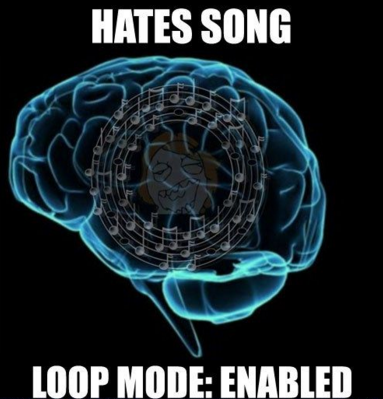
Ever run into a term you KNOW you’ve never heard in your life, then hear it at least four more times in the next week? Or see something you know you’ve never seen before, then suddenly it’s everywhere? Reverse-harems? Punk-Rockabilly-Zydeco? Kombucha?
I’d never heard of Bikram Yoga until a friend told me about it and then…it was everywhere. Following me with sweaty mats…and Kombucha O_O .
The Baader-Meinhof phenomenon is also known as the frequency illusion or the recency illusion.
At first glance, one might think this is why it’s a great idea to automate everywhere! Churn out lots of ads! Exposure! The more people see me, my name, my face, my book, the BETTER!
Not so quickly.
The Baader-Meinhof phenomenon seems to kick in strongest when there’s some kind of an emotional response tethered to the ‘thing.’
Interestingly, the stronger the emotional response (positive or negative), the more likely we will see that car, food, book, name, that we suddenly believe is now everywhere, surrounding us.
Ah, but when it comes to OUR brand, what emotional response are we creating? Are people seeing our name because of some good encounter?
Or do they see it and silently rage because we keep crapping up their feeds with automation? Are we all take and no give?
Ads That Pop-Up vs. Ads That POP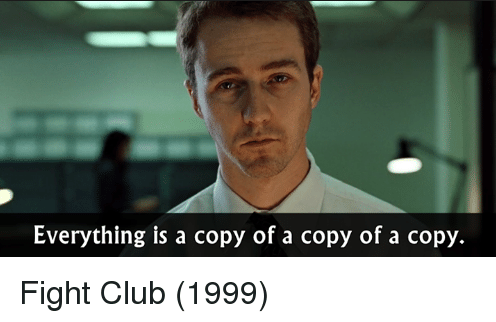
We see ads all over. More than ever before in human history, which is why our brains are getting so clever with shortcuts. Most ads we literally do not see.
I could take any random person and have them click through twenty pages of BuzzFeed memes and they’ll remember the memes (emotional), but are unlikely to remember most of the ads plastered all along the sides.
Though most ads will be invisible, some are not. Some might even leap off the page. Why?
What makes us ‘see’ that advertisement?
When we have a highly positive or vastly negative experience, we’re far more likely to notice the ad.
If we see an ad for a book, we may or may not notice. But what about an ad for a book written by someone we know?
Someone perhaps we talked to and liked? The ad practically leaps from the page. We might even buy it because we SAW her ad and OMG! I know her!
Ads alone have very little power to compel a purchase. But, couple them with a brand (story/narrative/emotional experience), and the odds of a sale greatly improve.
This is why ads and promotion alone do very little to impact sales. Until there is a narrative (emotion) attached to the name?
It’s crazy expensive white noise.
Ah, but what’s worse than a non-brand? A poisoned brand. If our brand is the story connected to our names (and by association our books), there can be nothing worse than the toxic brand.
The Biggest I’m just spreading awareness…
I’m just spreading awareness…The biggest brand fail I witness is how much authors underestimate the power of social media behavior and its consequential impact on their author brand.
Social media is a massive part of our everyday lives. Everywhere we go, we see people fixated on smart phones, posting pics, messaging friends. Humans are wired to be social, so if you want to know where all the readers are? They are on-line.
***Whether this is good or bad is for another post entirely.
This said, we must appreciate that this isn’t 2008, the age before smart phones, a time when only early adopters lurked on Twitter and MySpace.
Back before roughly 2015, the largest and strongest part of the author brand happened to be the books (because a book is roughly 15 hours of interaction with the author’s ‘voice’).
But now? When people are constantly checking in with their favorite social site(s)? How we ACT and treat other people is the biggest part of the brand. It doesn’t matter how well we write, how awesome our books are, or how cheap we make our product.
If we poison our brand with too many negative somatic markers, we can devastate our brand, regardless how well we write, and the reason is this:
The most powerful somatic marker of ALL is the negative one (namely because it’s intrinsically woven into our very survival).This is why that tuna salad that gave you food poisoning fifteen years ago still makes your stomach heave just thinking about it. Your body is warning you that this food might kill you (even though logically, you know this tuna salad is fresh).
The primordial brain doesn’t care about logic. Lizard-brain is ALL emotions and experiences and these experiences have a MASSIVE impact on our brand.
There are authors I used to preorder their books. Now? I wouldn’t accept a book of theirs even if it were free.
Why? Because they forgot that people are watching, that flesh and blood humans are on the other side of that screen.
Their ranting, raving, complaining, spamming, name-calling, and trolling comments eventually added up so many negative experiences that there was pretty much no way to counter the effect.
Branding is no longer just about the books.
Books are vital, but what elements are we adding to our story (our brand) when we’re online? When people see our content do they smile, laugh, feel good, want to share the fun? Or do they feel bullied, depressed, overwhelmed, targeted, or defensive?
Colin Shaw’s blog ’15 Statistics that Should Change the Business World but Haven’t’ collected some interesting stats that I’d like to share:
It takes 12 positive experiences to make up for one unresolved negative experience. – ‘Understanding Customers’ by Ruby Newell-Legner.
A dissatisfied customer will tell between 9-15 people about their experience. Around 13% of dissatisfied customers tell more than 20 people. – White House Office of Consumer Affairs.
70% of buying experiences are based on how the customer feels they are being treated. – McKinsey.
When we’re on social media…
Everything Matters in BrandingEvery post, comment, retweet adds to the story that is our author brand.
People might not remember exactly what we say, but they’ll always remember how we made them feel. In an age where audiences are flooded with too many choices, they’ll default to who they know, who they like, and who consistently makes them FEEL the best (loads of positive somatic markers).
Does this mean we can’t express opinions, that we need to be a cute kitten meme factory and Pod Person? Not at all. My advice is we’re wise to promote what we love instead of bashing what we hate.
For instance, if I’m a vegan and post ’12 Reasons Vegans are Sexier’ on Facebook, then fellow vegans will experience a positive somatic marker.
Those followers who aren’t vegans likely won’t react at all (a neutral somatic marker) because I’ve not placed them in the crosshairs of an attack. In fact, the non-vegan followers might even SHARE my post with vegan friends and family. And if not?
No big deal because we’re all still friends who can agree that we can be friends without being clones.
Oh, and we actually can disagree or inject a different opinion without being mean. Again, simply remember there are actual people on the other end.
Keeping the ‘Social’ in Social Media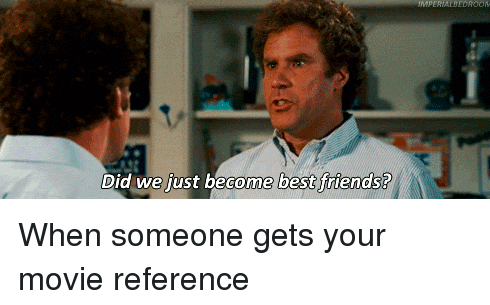
Now that y’all have had a Neuroscience 101 crash course—and I guarantee you will see Baader-Meinhof OR Kombucha at least three times in the next week—let’s get down to what’s most essential.
Branding is all story.
It’s a collection of emotional experiences that tie our name to some set of descriptors (hopefully positive ones). This is why automation can’t substitute for hopping on-line and talking to people. It’s why the Golden Rule still rules and why YES, goofing off on Facebook and posting kitten videos counts as branding.
Eventually, with love, care and nurturing, followers can become friends and even FANS.
So have fun. Relax. Show up. Be present and engage authentically. Go write great books and enjoy the people you meet along the way.
I love hearing from you, and I am NOT above BRIBERY!What are your thoughts on ‘branding’? Does it seem more doable now? The brands I teach y’all how to build are fun and simple and require minimal upkeep because you have brilliant books to write!
If you want a step-by-step on how to create a brand as unique as you that will specifically attract YOUR equally unique audience and then cultivate them into an amazing and supportive network of fans? Seriously, save time and money and just grab a copy of Rise of the Machines.
So again, any thoughts, questions, opinions? I do love hearing from you.
What do you WIN? For the month of JANUARY, for everyone who leaves a comment, I will put your name in a hat. If you comment and link back to my blog on your blog, you get your name in the hat twice.
What do you win?The unvarnished truth from yours truly. I will pick a winner once a month and it will be a critique of the first 20 pages of your novel, or your query letter, or your synopsis (5 pages or less).
DECEMBER’S WINNER Rae Longest. Please email your 5,000 word Word doc, Times New Roman, double-spaced, 12 point font to kristen at wana intl dot com. Put CONTEST WINNER in all caps in heading so I see you and CONGRATULATIONS!
Classes***Remember, ALL classes come with a FREE recording of class
Business ClassesAll classes taught by USA Today Best-Selling Author/Top Podcaster Cait Reynolds
The POD PEOPLE Podcasting BUNDLE: 3 Classes 1 Low Price
$199 for ALL THREE CLASSES. Normal FULL PRICE for all three classes is $377 USD or $317 USD even with all the early registration discounts
If, however, you choose to buy individually…
$99 USD
$129 USD
How to Make Money & The Business of Podcasting
$149 USD
Craft ClassesON DEMAND The Edge: How to Write Mystery, Suspense & Thriller (Kristen Lamb)
$65 USD Use Thrill10 for $10 off
***More craft classes coming next post. Apologies, but have has a cold for several days so running behind.
The post Branding & Attention: Busy Brains in a Busy World appeared first on Kristen Lamb.
January 10, 2022
Psychology of Selling: Understanding the Consumer

Psychology factors into most of what we do in modern life. Companies use psychology everywhere from human resources to building design. Understanding the human mind is a powerful tool.
Though not always deployed ethically (for more on this, refer to the book I recently coauthored, The Trap: Sex, Social Media and Surveillance Capitalism), please appreciate that experts are constantly employing psychological levers to get what they want.
For those who don’t yet know me, I’ll never teach anything unethical. Why would I teach you how to sell a TON of books if you just feel icky at the end of day? And yes, trust me, I have seen more than my fair share of seriously unethical ways to sell everything.
Yes, even books.
Spoofing
One short-lived grift (THANK GOD) shot to popularity in around 2011-2013. Though I don’t believe anyone gave it a technical name, for me, it was the equivalent of spoofing.
In the cyber community, spoofing uses the psychology of trust. A fraudulent party poses as a site, company, brand that consumers trust (E.g. they create a bank site that looks almost the same as a legit site). In the cyber world, the goal is to gain access to personal data, infect machines or steal money.
An almost identical tactic worked eerily similar in the early world of on-line publishing.
Book Spoofing: Psychology of Brand Loyalty Seems legit…
Seems legit…See, in the early days of e-readers, many big name authors either weren’t yet available on ebooks or they were very new to the digital world.
NYC was far from tech savvy, so many of their authors were sitting ducks. Book spoofing (a.k.a. BS) became a popular way to make a quick buck. What was book spoofing?
Unknown, unvetted ‘writers’ just used another author’s hard-earned brand to sell their books.
Readers gravitated by the droves and bought up authors they trusted, not realizing they were actually buying the book equivalent of a Polex watch or Louie Vuiton bag.
Fans were used to seeing these BIG NAME authors turn out a gazillion books and were aware many had insane backlists, thus they had little reason to question the veracity of the titles…until they began reading and realized they’d bought a steaming pile of crap.
Yes, writers con-artists actually did this.
A ‘writer’ would choose a nom de plume that was almost identical to a famous author (E.g. Nora Robert instead of Nora Roberts), then write in the same genre and craft covers to be deceptively similar.
***For the record, I am using Nora Roberts as an example, but YES these writers were foolish enough to spoof brands just as big.)
It doesn’t take much imagination to see the inevitable lawsuits. Despite my quite vigorous protest, plenty of writers played this ‘bait-and-switch’ with readers. They took advantage of Amazon’s emergent SEO system that (at that point) couldn’t discern imposters. Sure, these writers made a TON of money.
Some even tried to lure me over to do the same, boasting of all their riches.
I told them to make sure to save that money for a good attorney and leave me be. I’d earn any best-selling titles myself.
Psychology of Purchases
Now that I’ve given an example of how psychology can be used unethically to guide consumer decisions, we’ll move on. Yes, I released my branding book Rise of the Machines: Human Authors in a Digital World in late 2013.
I’ve not written any other branding books because Rise of the Machines is evergreen. Gizmos and platforms and social media sites change all the time. Heck, the entire internet is about to change.
Welcome Web 3.0. Yep, it’s coming.
But you know what never changes? People. Understand people and that is 90% of what you will ever need.
What makes people click, share, read, engage? Why do they buy what they buy? What converts a passive browser to a vested consumer, and a vested consumer into an evangelical super fan?
Search engine optimization, rules for meta data, etc. change constantly. It’s almost a full-time job keeping on top of that.
We can hire the best SEO team, have all the plug-ins and be on all the sites, but if we have the wrong core imperatives? We might as well pile cash on the ground and set it on fire.
Products are NOT One-Size-Fits-All.
Low-Consideration vs. High-Consideration
Almost all purchases can be divided neatly into two distinctive categories—low-consideration purchases and high-consideration purchases.
Low-consideration purchases usually aren’t terribly expensive, are common, have a lot of competition, and are something the consumer was going to buy ANYWAY. Haven’t you ever wondered why toilet paper companies spend tens of millions of dollars in marketing?
Who is NOT using toilet paper?
No one is hopping on internet forums to ask experts what is the best toilet paper to buy…and if you are? Um, that’s weird.
Toothpaste. It costs only a few bucks and, if I hate the taste? I toss it. Toothpaste, by and large, is not an emotionally driven experience.
The reason that ads, coupons and FREE work so well with low-consideration purchases is these typically are inexpensive products we probably were a) going to buy anyway or b) were so on the fence that a $2 off coupon or buy-one-get-one-FREE could tip the scales.
High-consideration purchases are the exact opposite.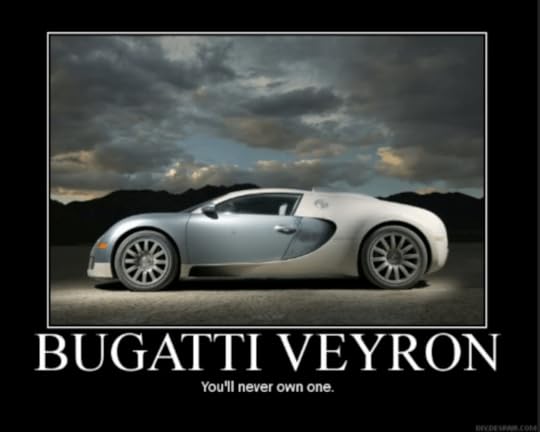 Which is why people WANT one.
Which is why people WANT one.This is when human psychology becomes a game-changer. High-consideration purchases usually cost more, are highly emotional, fueld by peer pressure, and are NOT typically something we’d normally buy.
One might need a car, but no one buys a Bugatti for practical purposes. A $600 generic laptop from Sam’s Wholesale probably works just as well for most users as a $3,800 MacBookPro. A purse from a thrift store can hold my crap just as well as a real Louis Vuitton (probably better since it wouldn’t be a theft magnet)…and yet?
Why are people willing to fork out absurd amounts of money when there are super cheap substitutes that might even work better? Heck just an OIL CHANGE for the Bugatti Veyron is $21,000.
Trust me, if someone is about to drop the equivalent of a year’s salary or more on a car, a boat, a motorcycle, they research. They are on message boards to make sure they’re getting the BEST of the BEST. When it comes to luxury cars, boats, watches and expensive clothing, computers, and accessories? It is largely about EMOTION and is peer pressure powered.
It’s all psychology.
Psychology of Book Sales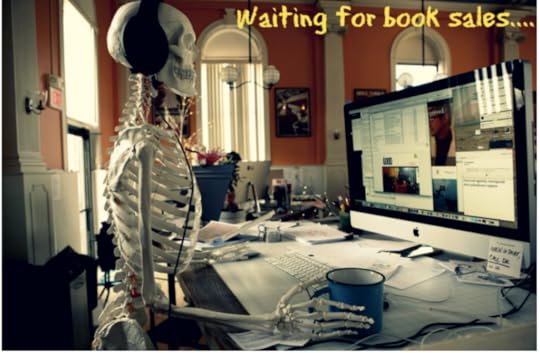
Some of you might be asking what the point of all this is? The point is too many authors fixate on the price of the book and forget the psychology driving the purchase.
At first glance, a book seems to be a low-consideration purchase. I mean, most books cost about the same as a tube of toothpaste. No more than a box of generic teeth-whitening strips. So authors run promotions (coupons) and giveaways and offer FREE books!
*crickets*
So why don’t the tactics that normally boost sales for toilet paper and toothpaste NOT work for books?
Because books, ironically, are a high-consideration purchase. Most people do not like to read *all authors collectively gasp in horror.*
It’s true. If you polled the majority of the population and asked for a list of the top ten things most people love doing in their free time? Reading probably not on the list. In fact, something like 94% of the literate population doesn’t like reading.
Herein lies the rub. We (authors) see the price of our book, but the consumer sees the COST of their TIME. Time is their most valuable resource and no one ever seems to have enough.
Thus, when we go to sell a book, essentially what we are asking is for people to PAY MONEY and give up 12-15 hours of precious and nonrenewable time…to engage in an activity they believe they dislike.
No pressure there, right?
Why Marketing DOES NOT SELL BOOKSWhen I say marketing, I mean traditional marketing. As I just mentioned, if we simply look at the MSRP, books appear to be a low-consideration purchase when they are, in fact, a HIGH-CONSIDERATION purchase.
Book sales are driven by brand and buzz. Most of the big brands are there to stay. Robert Ludlum and Tom Clancy are still hitting the NYTBS lists even though both authors passed away years ago. Ludlum passed in 2001 and Clancy in 2013.
Unknown but skilled authors, however, are still keeping these colossal brands alive and thriving. The fans remain happy because a) there is a degree of brand integrity they can trust and b) they still get to enjoy new books from their favorite brand.
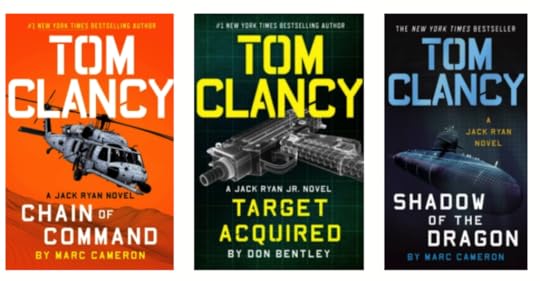 How many readers looking beyond that BIG NAME at the top?
How many readers looking beyond that BIG NAME at the top?Even people who typically do not read will happily shell out the full price of a Brad Thor, Stephen King, or Sandra Brown when trapped in an airport because they know and trust the names (code for ‘brand’).
FOMO & Psychology of Sales Social media and FOMO
Social media and FOMO When regular people (code for ‘readers’) ask me what I do for a living and I tell them I am an author? At least 80-90% of the time the first question they ask me is whether or not I’ve read 50 Shades of Grey.
And I’ve found at least 50 ways of politely saying, “No.”
No shade on E.L. James (and no pun intended) because she created a cultural phenomenon. Whether this book is my cup of tea or not doesn’t matter. Good for her for generating FOMO.
There is a psychological lever often referred to as FOMO (Fear of Missing Out). This is one of many reasons this book became SO BIG. It garnered SO MUCH BUZZ that those who’d not yet read the book felt a sense of peer pressure to see what all the hype was about.
The same can be said about Game of Thrones. Without the HBO series, how many regular people would have bothered with George R.R. Martin’s A Song of Ice and Fire books? How many people read The Hunger Games, Twilight, The Martian, Girl with the Dragon Tattoo, Gone Girl, etc. simply because they’d heard SO MUCH BUZZ they finally felt they were missing out?
I guarantee you there are people who own the entire Harry Potter series in hardback but who are unlikely to read anything else and would not consider themselves ‘readers.’
The Psychology of ExpectationPart of the reason the mega brands have so much power is consistency. People KNOW what to expect.
It’s why people (okay, Americans) vacation in exotic places and STILL go to Chili’s or On the Border for dinner. X, Y, Z brand may not be the BEST quality—McDonald’s—but consumers at least know what they are in for.
This is the same with all brands, even in storytelling. Why is Hallmark such a MASSIVE brand? We’ve seen the memes picking on Hallmark movies.
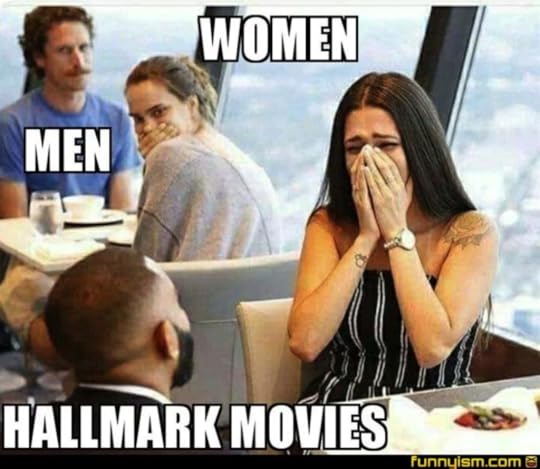
Guess what? Hasn’t stopped them from having their OWN CHANNEL. Hallmark is a force because they KNOW and UNDERSTAND their audience. They provide—in a movie—what most people never will experience in real life but long to. Hallmark doesn’t need to be super complex, thought-provoking, and deep because that is NOT its brand.
People who want to watch movies with 5 subplots and 15 characters are NOT their audience. Why would Hallmark try and meet expectations of those who are not their consumers?
 NOT Hallmark’s demographic.
NOT Hallmark’s demographic.Romance/Erotica accounts for almost $1.5 BILLION in book sales. JUST BOOKS. Why is romance such big business? Again, the psychology of expectations.
Obviously all genres adhere to some sort of a formula, but the strictest of all is romance.
Romantic Interest A meets Romantic Interest B. They initially clash/don’t like each other BUT over time come together as a couple/team to solve greater problem. In the end, there is a Happily-Ever-After or the more modern Happily-For-Now.
Obviously, romance is an incredibly sophisticated genre. The above formula can be executed in any number of ways with any degree of complexity. But, at the end of the story, if Romantic Interest A and Romantic Interest B are not in some way TOGETHER? NOT A ROMANCE.
Whether it is pasta or podcasts or boutiques or blogs, branding is essential. What is a brand?
When a NAME ALONE has the power to drive sales.
From Hallmark to Hello Kitty, Rolex to romance, consumers need to trust what they are buying/devoting their time to.
What is the Takeaway?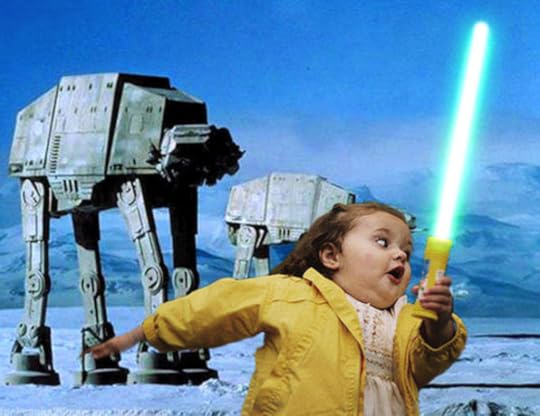
For the WHOLE enchilada about consumer psychology, branding and more, pick up a copy of Rise of the Machines. Since this is a long-ish blog post? We can only cover so much.
The key takeaway is we, as authors, must look beyond price and understand why people buy books. It doesn’t matter if we get great reviews in literary publications (sites) because the regular everyday person isn’t going there.
They’re checking out clothes on Instagram or laughing at TikTok videos. FREE books aren’t going to lure them away from their habits.
Sure, there is a time and place to use FREE, but it’s frequently overused/misused and devalues our product more often than not.
When we appreciate that our goal isn’t a race to the bottom of who can give away the most for free or almost free, that is liberating.Once we know that we don’t need pay to constantly blitz out ads and marketing campaigns like other products, we can work smarter, not harder.
What Are Your Thoughts?Now that you understand some of the psychology behind why people BUY, does it make sales seem a more manageable? Did you ever wonder WHY manufacturers advertise toilet paper? Does this take some of the pressure off knowing how much we really do control (quality, consistency, quantity, reliability)?
Any thoughts? Additional comments or questions?
Make sure you scroll down and sign up for one of the new classes. Only the BEST for you guys!
I love hearing from you, and I am NOT above BRIBERY!What do you WIN? For the month of JANUARY, for everyone who leaves a comment, I will put your name in a hat. If you comment and link back to my blog on your blog, you get your name in the hat twice.
What do you win?The unvarnished truth from yours truly. I will pick a winner once a month and it will be a critique of the first 20 pages of your novel, or your query letter, or your synopsis (5 pages or less).
DECEMBER’S WINNER Rae Longest. Please email your 5,000 word Word doc, Times New Roman, double-spaced, 12 point font to kristen at wana intl dot com. Put CONTEST WINNER in all caps in heading so I see you and CONGRATULATIONS!
Classes***Remember, ALL classes come with a FREE recording of class
Business ClassesAll classes taught by USA Today Best-Selling Author/Top Podcaster Cait Reynolds
The POD PEOPLE Podcasting BUNDLE: 3 Classes 1 Low Price
$199 for ALL THREE CLASSES. Normal FULL PRICE for all three classes is $377 USD or $317 USD even with all the early registration discounts
If, however, you choose to buy individually…
$99 USD (Use Code New20 for $20 OFF if REGISTERED BY JANUARY 14th)
$129 USD (Use Code New20 for $20 OFF if REGISTERED BY JANUARY 14th)
How to Make Money & The Business of Podcasting
$149 USD Use Code New20 for $20 OFF if REGISTERED BY JANUARY 14th)
Craft ClassesON DEMAND The Edge: How to Write Mystery, Suspense & Thriller (Kristen Lamb)
$65 USD Use Thrill10 for $10 off
***More craft classes coming next post
The post Psychology of Selling: Understanding the Consumer appeared first on Kristen Lamb.
December 30, 2021
CHANGE: A Simple Formula for the Life You WANT

‘Change’ is a pretty big buzzword about this time of year. New year, new me and all that jazz. How many of us, year after year after year make lists, draft resolutions, and vow THIS time we’ll not only change, but change for good, but….
*insert sound of deflating balloon here*
There are many reasons why we might not be getting the results we want. Maybe we are trying to alter the external symptoms instead of searching for the internal causation. Perhaps we are trying to change and we aren’t the actual problem. We might be taking on too much too quickly.
Yada yada yada…every New Year’s post ever. Right?
I hope not. I’d like to (hopefully) take a different approach. What does change really mean? Let’s look to the word.
C-Catalysts are Necessary for CHANGE
I get most of you have probably slept since Chemistry class, but this is simple enough. If I’m in a lab, and I want to change one substance into a different substance, then what is one necessary ingredient?
A catalyst.
I must add in another ingredient that shakes things up, that forces one or more elements to give up, add, share, or exchange electrons. The catalyst fundamentally alters the original substance and a byproduct of all this change is—drum roll—HEAT.
What can we take from this? Well, 2020 was a Dumpster fire and 2021 wasn’t that much better. Why did we moan and groan? CHANGE.
And trust me, most of us FELT the HEAT.
Yet, how did a string of seriously inconvenient/terrifying/world-altering events change us for the better?
Maybe we learned patience, how to be kinder, the importance of self-care. We might have become keenly aware of just how much we’d taken for granted (family, concerts, travel, dining out, shopping, going to a workplace with real, living people).
All great changes that never would have happened without a catalyst.
H-Help is Available
How many times do we try to change but we try to do it on our own? We are embarrassed, ashamed, or maybe just underestimate our own abilities. Hey, I am as guilty as anyone.
I used to LIVE in the gym…then COVID happened and my gym shut down for months. THEN, I went to a specialist and found out I had Hashimoto’s Disease. I eat crazy healthy because of all my food allergies. But, between stress, illness, numerous deaths, being sedentary, and my regular doctors ignoring a serious thyroid issue? I put on weight.
Aaaand that is why I go to the gym when no one is there.
It’s silly. I KNOW. But I’m too embarrassed to attend my old group classes or go to a trainer because I’m ashamed. In this instance? HELP would probably be a good thing.
However, if I can’t set aside my ego and ask? I’ll make reaching my goal of not having to live in yoga pants forever much harder to reach.
A-Action Matters
Some people say starting is the hardest part. True. When it comes to a LOT of things, I say FINISHING is the hardest part. Yet, when applied to how we live our lives? We won’t be ‘finished’ until we’re dead.
So starting it is!
Too many people underestimate the power of small actions every day, day after day, week after week, month after month.
We all want the HUGE change. I mean, I don’t get it. Most of the time, as I mentioned, I eat ridiculously healthy. But I have two pieces of pizza and it feels like I grow an extra @$$ overnight. Go four days eating holiday food and it is a HUGE difference. So why shouldn’t eating four days super healthy be the same?
It isn’t. We all know it doesn’t work this way, and yes I am bitter about it.But it is what it is. Instead of fixating on an entire lifestyle overhaul, pick a handful of actions that would get you where you want to be…then do that over and over and over.
Wanna lose weight? Drink water, get to bed at a reasonable time, set a timer and move throughout the day, etc.
When I was pregnant, I did two-a-days the entire 10 months. I swam a mile in the morning, then did weights in the evening with Hubby. How did I do this? I told myself all I HAD to do was walk into the gym and do FIVE minutes. If, after FIVE minutes, I felt ill, weak, tired, horrible (which when you’re pregnant is legit), then I could leave.
In all ten months I only left TWICE.
Instead of setting a goal to work out three days a week, try setting a goal of just checking into the gym three days a week. Why? Because once you’ve gone that far, usually you’ll at least do SOMETHING, which is better than nothing.
Same with writing. Set a goal of 250 words. That is A page. Once you finish 250? If you have to go? Go. But do this day after day and soon you’ll have a first draft and then a novel.
N-Nerve Can be a GOOD Thing
Nerve can be defined as, “the power of endurance or control.” Obviously, this is critical for generating and maintaining change. Yet, nerve also has a negative connotation that means to be presumptuous, to have the audacity or gall to do X.
I grew up in a rather toxic family, and I imagine I’m not alone in that. Did you have members of your family who shamed you for wanting, for dreaming, for daring to forget your place? ‘Friends,’ colleagues, acquaintances who mocked, undermined or sabotaged you for wanting to do something different or to dream big?
Those negative messages can feel all but impossible to erase.
For example, I was largely reared by my Great Depression grandparents. In ways, this was great because I am frugal, I save, I’m an excellent money manager. But, at the same time? I deprive myself and feel guilty for taking a break, a vacation and GOD FORBID…buying myself something nice.
TRUE STORY About CHANGE
My grandfather helped me buy a used Mazda for college. Back in the 90s, however, there were no Lemon Laws and you really had no way of properly vetting a car. My grandfather had a unique talent for picking the biggest lemon on the lot.
I spent thousands of dollars on repairs, and even learned to do many repairs myself because poverty is the mother of innovation. Finally, I was tired of going to school full-time and working two jobs only to have most of my income go to yet ANOTHER stupid car repair.
By some stroke of fortune, I happened to date a guy who did body work. He took one look at my Mazda and told me the reason I had so many problems was the car had been in a major collision. Whoever owned it had done the superficial body work, but the internals were a mess.
What did I do? I went out and bought my first new car…the most embarrassing car possible. But, it was cheap. No electronic locks or windows (fewer things to break), and it was a stick shift (cheaper than an automatic).
Funny fact? I had ZERO idea how to drive a stick. My dad had taught me, but I’d slept since I was ten (it was the 80s).
Meaning, I very literally bought a new car then TAUGHT MYSELF how to drive the darn thing on the back roads behind the dealership.
It was a Geo Metro. FANCY!
FANCY!My car was basically a highway-ready lawnmower that almost shook to pieces if I went over 65 mph.
Though it was technically a Chevrolet, I knew it had a Honda engine and it got up to 45 miles per gallon. My car payment was $200 a month and my insurance dropped to like $60. Not only that, but the dealership gave me a $400 gas card with purchase…which lasted at least SIX MONTHS (including long road trips).
I rushed home to show off my “new car” expecting my grandparents to be proud. Even though I went to a fancy private school (scholarship, of course) where most kids drove BMWs and Range Rovers, I’d chosen to be responsible. AND I was willing to proudly park my pregnant roller skate next to any Mercedes.
But what happened?
My grandparents shamed me and berated me for having the NERVE to buy a new car. Didn’t matter that it had a warranty, no damage, was super reliable and cheaper than repairing a used car over and over and over. No, I was out of line for daring to buy something that wasn’t used.
To this day? I struggle. I’m learning to trade in the toxic nerve for the good kind of nerve. Learning I can have nice things and feel GOOD about it.
E-EVERYONE has Same 24 Hours…is BULL SPRINKLES Me homeschooling and being self-employed.
Me homeschooling and being self-employed.For more on this, refer to a previous post Advice: The Great, the Bad & Good Intentions Turned Toxic Dogma.
I see this idea all over social media and quoted in books and it is total and complete horse $#!&. But, how many of us run out and buy motivational books? Books on goals and reaching our dreams, and what do many of them do?
SHAME US for not trying HARD enough.
No, I call bull sprinkles.
Leonardo DaVinci did NOT have the SAME 24 hours unless he was doing laundry, bills, dishes, homeschooling, answering emails, and forced to attend pointless meetings about why no one is being productive….while paining The Mona Lisa.
I don’t recall Einstein having to drop the chalk and set aside The Theory of Relativity, to run and pick up a kid who was puking at school.
Did Walt Disney pioneer animation WHILE taking care of young children and elderly parents and also working 40 hours a week in retail hell? NO.
And Arianna Huffington? I won’t go there. If you want more, feel free to read Shame on You AOL/Huffington! NO More Literary Booty Calls.
So help me, if I read one more motivational book written by someone who can afford STAFF who then berates regular working people for not using their time wisely? I WILL have a book burning.
And yes this last one has me ranty, but we have to ditch the lies.
Comparing Apples and Unicorns Do we REALLY HAVE SAME 24 HOURS AS BEYONCE?
Do we REALLY HAVE SAME 24 HOURS AS BEYONCE?I love motivational books, but frankly? A lot of them are a formula to fail.
Let your mind rest, play, and ignore people who tell you if you aren’t working a gazillion hours a week, you suck. Because, you know, famous workaholic CEO Marissa Mayer is a fabulous role model.
She enjoyed working 100+ hours a week! Go her. But she also expected the same level of dedication from employees. Of course, what’s missing? She built a private nursery next to her office after having her child. Did all the Yahoo employees have private nurseries next to their cubicles?
Going out on a limb, but I’m pretty sure they didn’t.
My point being…it’s a double-standard and learn to recognize and reject when a certain level of expectation is absurd. People who can build private nurseries and have a shower in their office have a very different 24 hours, and GO THEM!
You don’t think that I wouldn’t LOVE a full-time housekeeper, trainer and personal chef? No shame on people who have that, just don’t act like we all have the same day. I believe it is critical I use what time I have WISELY, but the amount of TIME is going to vary from person to person.
Change for the BetterIn the end, I wish everyone a wonderful, fantastic and life-changing (in a good way) 2022. Expect there will be heat, ask for help, remember small actions ADD UP OVER TIME, believe you deserve your dreams, and maintain healthy perspective.
What are your thoughts on CHANGE?I hope y’all feel empowered. Some of this advice is probably old but tried and true. Hopefully, however, I’ve offered some fresh perspectives.
If you have any tips or suggestions to add, I love learning new tips and tricks.
But do you feel defeated? Shamed because you are never DOING enough? Especially now that people are working from home a lot more. Are you crushed under the weight of ridiculous expectations (whether from yourself or others)?
Do you struggle with asking for help? Is it hard for you to relax without feeling lazy Do you feel guilt if you buy yourself something nice? Selfish if you dare to dream big?
I love hearing from you, and I am NOT above BRIBERY!What do you WIN? For the month of DECEMBER, for everyone who leaves a comment, I will put your name in a hat. If you comment and link back to my blog on your blog, you get your name in the hat twice.
What do you win?The unvarnished truth from yours truly. I will pick a winner once a month and it will be a critique of the first 20 pages of your novel, or your query letter, or your synopsis (5 pages or less).
***New 2022 classes will be listed next post. HAPPY NEW YEAR!
The post CHANGE: A Simple Formula for the Life You WANT appeared first on Kristen Lamb.
December 10, 2021
Talk is Cheap: Harness the True Power of Dialogue
 Via ‘Bill & Ted’s Excellent Adventure’
Via ‘Bill & Ted’s Excellent Adventure’“Talk is cheap.” This is a common idiomatic expression, at least here in the States. While these might be words to live by, they are also words to write by. Dialogue can make or break story. It can make a ‘meh’ story concept shine or tank a superlative story idea.
Talk, or lack thereof, is therefore crucial.
I strongly recommend every serious writer buy then STUDY Robert McKee’s book, Dialogue: The Art of Verbal Action for the Page, Stage, and Screen.
McKee defines dialogue as, “Any words said to any character by anyone.”
He also states:
All talk responds to a need, engages a purpose and performs an action. No matter how seemingly vague or airy a speech may be, no character ever talks to anyone, even to himself, for no reason, to do nothing.
McKee, Page 3
In McKee’s book, he explains how novelists wield far more creative power than stage or screen writing. When we write what is called the ‘narrative,’ this counts as a form of dialogue. It is talk between the POV (Point of View) character and the reader.
Novelists can truly BE gods of their own worlds.
Author God Via ‘Monty Python and the Holy Grail’
Via ‘Monty Python and the Holy Grail’While other ‘artists’ use paint, clay or other physical, tangible materials to ‘create,’ writing is completely abstract (particularly in short stories and novels).
Writers use various combinations of 26 letters to create characters that feel so alive, audiences can very literally go into a sort of depression when a story or series ends.
Authors create new worlds, languages, religions, dimensions, creatures and PEOPLE that have never existed all solely using various combinations of letters. And, frankly I’d say we have more like 23 letters since Q, X, and Z are all but useless most of the time.
We can use ‘talk’ to inform, disrupt, distract, enlighten, or even misdirect. Thus, today, I’d like for us to explore the purpose of dialogue.
How can we use ‘talk’ wisely? In the interest of time, today we’ll look at some of what spoken dialogue can and should do and cover writing the narrative another day.
Dialogue and Characterization From ‘Napoleon Dynamite’
From ‘Napoleon Dynamite’The most obvious use for spoken dialogue is that it defines, deepens, and distinguishes each character. We can use vocabulary, idiomatic expressions, and subtext to inform the audience without spoon-feeding them as if they’re stupid.
Dialogue is one of the many ways we, as writer god, can craft human beings with loves, loss, and layers simply by crafting how they speak (or don’t).
Talk, Vocabulary & SubtextWhether in speaking dialogue or narration (thinking), vocabulary is critical. Vocabulary is a treasure trove of information How a character talks can reveal age, where the character is from, belief systems, educational level, background, vocation, interests and more.
In the first example I’ll riff a section of dialogue and layer in subtext (what is being said without being said) which leaves gaps for the audience to fill in the blanks.
Example One:
“Lord, it is hotter than the hammered hinges of hell out here. You think Delroy’s really stupid enough to hole up at his mama’s place again?”
“I know he is.”
“Well, la-dee-dah, aren’t we confident?”
“There is a vast difference between confidence and certainty. Your Delroy believes his laptop has been totally wiped. Yet, data can never truly be destroyed, at least not for those of us trained in the art of resurrection.”
“Great. Since I’m sweating my balls off, maybe you can turn this here water into a cold beer.”
“Don’t be pedantic.”
“Not paid enough to be. Only paid for small words.”
“Clearly.”
“That and to collar inbreds who diddle with kids on-line. And, you know, to make sure they don’t accidentally get hurt too bad on their way to booking.”
“I’ll pretend you didn’t just say that.”
Talk Analysis
Now, I have not named either of these characters but do you see all the information we can mine from how each person talks? This snippet of banter informs us we are probably in the American rural South.
Character OneWe know this from the Character One’s colorful description of the heat, the name ‘Delroy,’ his use of the idiom ‘holed up’ and the descriptors of ‘his mama’s place,’ ‘inbreds,’ ‘diddle,’ etc.
It’s also fair to assume Character One is male, since he’s ‘sweating off’ a uniquely male part of human anatomy. The audience might also glean that this character goes to church or has a history of church attendance because of his jab to his braggart partner about turning his water into a cold beer (a clear reference to Jesus turning water into wine) in reaction to the partner using the word ‘resurrection.’
He isn’t a die-hard religious man, but he is schooled enough in the faith to cleverly banter.
The first character seems affable and self-deprecating, since he’s only ‘paid for small words.’ We also get a sense that he has a very fluid sense of right and wrong. There is by the book (arrest a pedophile) and by HIS book (he hints Delroy might have some ‘accidents’ on the way to the station).
There’s also a suggestion Delroy is a repeat offender since Character One clearly states, “holed up at his mama’s place again.” We can infer then, that this isn’t Delroy’s first run in with the law.
Character One uses the word ‘collar’ and ‘booking.’ This is law enforcement vernacular.
 Speech MAKES character.Character Two (in BLUE)
Speech MAKES character.Character Two (in BLUE)The second character is, from all indications, far less emotive. This character is obviously highly educated, expertly trained with computers, and confident almost to the point of bravado.
Since the second character only uses two contractions, this could point to English as a second language or simply a stiff/formal personality.
Also notice this character refers to the suspect as “Your Delroy” which intimates this character is an outsider possibly new to the area or at least brought in to assist. Talk indicates this person doesn’t identify with the community.
We also get a peek at Character Two’s moral compass as well. He (or she) doesn’t directly challenge Character One when he hints at being rough with the suspect, merely claims neutrality on the matter.
Maybe this person is the type to look the other way, or maybe this is a gentle hint to Character One that he’s been warned that Character Two doesn’t like that kind of nonsense and could possibly report any unsanctioned behavior.
With dialogue, we can also guess that the pair are probably on a stakeout and at least one if not both are members of law enforcement.
See HOW MUCH we are able to mine out of fewer than 150 words of dialogue? We get setting (hot), location (rural South), vocation, education, moral compass, objective, background, etc. etc.
Talk & Holding the Reader’s Brain
In this next example, I’ll write the same scenario, but remove all the subtext.
“Texas summers are really brutal. It must be a hundred and ten degrees outside. I can’t believe we’re having to wait on our suspected pedophile to show his face. Surely he isn’t dumb enough to hide at his mother’s trailer. That’s where I arrested him the past three times. Are you sure your computer skills are good enough to be sure he’s here?”
“I am certain he at this location. I graduated top of my class at MIT. Pawn shops only wipe enough personal data for a laptop to be resold. By downloading a recovery program, I was able to reconstruct not only his last emails to his buyer, but I could re-pixelate the child pornography he is trying to sell today. His pawn shop friends really didn’t clean his computer totally. All the evidence is still there.”
“Geeks who sit at a desk aren’t real cops. I’m still not sure you know what you’re doing.”
Okay, I am stopping here because I can’t stand anymore, and I believe that’s enough to make my point.
Editors have the mantra, “Show don’t tell” and this can be used in the narrative, but it can also apply to dialogue. Alexa could have crafted this dialogue it is so devoid of humanity.
Yet, as an editor and avid reader, I cannot tell you HOW OFTEN I see dialogue like this. It’s stiff, contrived, and leaves no room for the imagination.
Good Talk vs. Bad Talk
What determines the quality of spoken dialogue? Writing quality, to a degree, is subjective. One could reasonably say the same about dialogue.
Quentin Tarantino fans don’t care his characters use so much profanity they leave sailors clutching their pearls. Me? When the F word is every part of speech? It’s too much and, over time, detracts from the story.
But that’s just me. Tarantino’s excessive use of profanity, however, is a style choice and isn’t what I’d deem as ‘bad’ or ‘amateurish’ dialogue.
Obviously, if you want the full deep-dive about dialogue, get the book I recommended. We can only cover so much in a blog post.
One of the reasons I suggest at least doing a log-line ahead of time is because then we know the ideal characters to cast, how they’ll need to arc, what they are likely to resist, and, most importantly…the ultimate objective.
How does the story end?
If we know these critical pieces of information, then dialogue becomes much easier.
In my made-up dialogue, what is the scene objective? To arrest Delroy. This informs what my ‘characters’ then talk about. I can also inject tension. Character One isn’t so certain his computer nerd partner has it right and for all he (or the reader knows), this could be a miserable waste of time.
Dialogue hooks the reader because we want to know which speaker is correct. I could end the scene any way I want. Delroy might be inbred, but he is after all, a repeat offender. Maybe this is a decoy.
Maybe the reader expects they’ll arrest Delroy, but then I flip their expectations upside down and they’re both wrong. Delroy is a victim, a patsy they find dead. Someone even better at computers set him up…but who?
Suffice to say, when we know how our story ends, we up with much less ‘filler’ and wasted dialogue that does little more than pads the word count.
Remember How People Talk
I’m a notorious eavesdropper. I study HOW people talk and how they DO NOT talk. Granted there are always exceptions, but here are some tips.
By and large, people don’t call each other by name when having a conversation.“Hey, Julie, how is your son Aiden doing at Middlebrook Elementary?“
“Well, Danielle, Aiden is doing much better since he left Green River Elementary.“
“Oh, Julie, that’s so good to hear.“
WHO TALKS LIKE THIS? Robots. Robots talk like this.
Unless we’re flagging someone down trying to get their attention, we generally don’t use their name. We certainly don’t keep using it
People don’t rehash commonly known information.This is called, “As you know, Bob” dialogue.
“Julie, as you know, Aiden was diagnosed with severe autism two years ago, which was why my husband, Tom and I, had to change where he went to school.”
Most of the time, people don’t speak in complete and grammatically correct sentences.Unless this is a unique affectation (E.g. the character Data from Star Trek), don’t feel the need for every character to speak perfectly and in complete sentences.
In conversation, usually one person won’t speak more than three sentences.They CAN, just if we have them go on monologuing too frequently, it sounds weird (refer to Example Two above). When you see you have a LOT of sentences, that’s a good clue you might be trying to hold the reader’s brain and are using dialogue to dump information.
A great trick of the trade is to read your dialogue aloud (without tags) to another person. If you stumble over places, then smooth out the wording. See if the person listening can tell your characters apart simply by they way they talk.
Remember, speech patterns, vocabulary, pace, etc. can do more to distinguish characters than all the physical description we might want to lavish on every character. We’ll remember their dialogue long after we’ve forgotten eye color and hair color.
Talk Saves Us Description
I LOVE pretty prose as much as the next lexiphile, but dialogue is so much more revealing.
“If you need a friend, get a dog.”
“Bogus. Heinous. Most non-triumphant. Ah, Ted, don’t be dead, dude.”
“Never thought I’d die fighting side by side with an Elf.”
“Cause Chevy didn’t make a 327 in ’55, the 327 didn’t come out till ’62. And it wasn’t offered in the Bel Air with a four-barrel carb till ’64. However, in 1964, the correct ignition timing would be four degrees before top-dead-center.“
I chose four vastly different characters. But, can’t you just envision the types of people who’d speak this way? Even if you don’t KNOW the first is Gordon Gekko from Wall Street, you still know this character is blunt, cold and doesn’t waste time with feelings.
Would I NEED to slather on a paragraph describing surfer dudes after that line from Bill & Ted’s Excellent Adventure?
This third example might not jump out right away, but I don’t even need to explain this is from a fantasy because of word choice. It is the dwarf, Gimli, from The Return of the King. We GET it is a fantasy and don’t need to wax rhapsodic describing how dwarves and elves have been long-time enemies. Dialogue accomplishes this with a couple words.
And #4? I threw that in for fun. Who can guess the character?
What Are Your Thoughts on TALK?What are your favorite quotes? Lines from screen, stage or screen? Do you see how powerful a tool dialogue can be? Does this give you ideas how to tweak how your characters speak?
I love hearing from you, and I am NOT above BRIBERY!
What do you WIN? For the month of DECEMBER, for everyone who leaves a comment, I will put your name in a hat. If you comment and link back to my blog on your blog, you get your name in the hat twice.
What do you win?The unvarnished truth from yours truly. I will pick a winner once a month and it will be a critique of the first 20 pages of your novel, or your query letter, or your synopsis (5 pages or less).
***We will be loading fresh classes for 2022 soon.
ClassesThe Edge: How to Write Mystery, Suspense & Thriller is available ON DEMAND (sign up HERE and use Thrill10 for $10 off). The recording turned out FANTASTIC, so check it out.
The post Talk is Cheap: Harness the True Power of Dialogue appeared first on Kristen Lamb.
November 19, 2021
Dune, Dialogue, Wishing Sand Worms Would Kill Me

Dune…desert planet…no dialogue. Before we plunge ahead in our ‘sit-still’ suits, I promise to work very hard to avoid any ‘spoiler alerts.’ Though, in my defense, this story has been around since disco was cool.
Also, feel free to disagree with my opinion, just please do so politely. Videophiles and cinephiles will LOVE this movie. For the record, I am not arguing about the breathtaking cinematic beauty of the movie. That was spot on.
…it’s just the rest I’ll pick to pieces.
Why am I taking the time to critique the remake of Dune? Other than the obvious answer that there are a TON of amazing stories out there that Hollywood hasn’t already remade?
It has to do with one of the key fundamentals of the writing CRAFT—dialogue. Dialogue is more than talking, and when writers fail to appreciate that, we end up with forgettable books, plays and yes, movies.
Today I am not going to deep-dive all the ins and outs of dialogue, but I will use the rerelease of Dune to show—NOT TELL—why dialogue is critical for excellent storytelling. We’ll cover some essential points about dialogue, then I’ll cross-apply this to why Dune 2021 left me more than a little underwhelmed.
Dialogue Makes Stories Iconic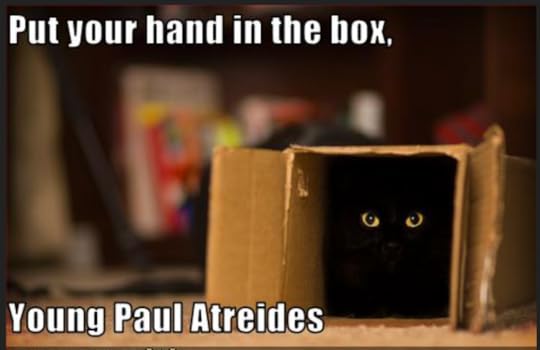
I feel I am uniquely qualified to critique the new Dune because a) I am a hopeless nerd b) I have read the unabridged books so many times it is no mystery I was single until age 35, and c) I’ve watched the original movie so many times I know every line by heart.
Dialogue is one of the key factors that can elevate a story to a legend.
It was the best of times, it was the worst of times.
Leave the gun, take the cannoli.
T’is a flesh wound.
Son, your ego is writing checks your body can’t cash.
That’s my stapler.
Winter is coming.
I worked hard to give numerous examples. The first is from Charles Dickens’, A Tale of Two Cities, a book long enough to brain a burglar. Most people recognize this quote, even though I would venture to say that, though they know the quote, they’ve never read the book.
I haven’t.
This one quote has lived on and is used in conversation, movies, etc. You might be yelling at me right now and saying, “But Kristen! That isn’t dialogue, that is narration.”
And that would be traditional thought. But, according to Robert McKee’s GENIUS book, narration is dialogue and he explains why on page 3. We’ll also talk about this more in another post.
How many books, series or movies do we quote without even thinking? Lines that have woven themselves inextricably into our culture and even become part of our cultural lexicon? Dialogue is LIFE.
We KNOW Our People Because of Dialogue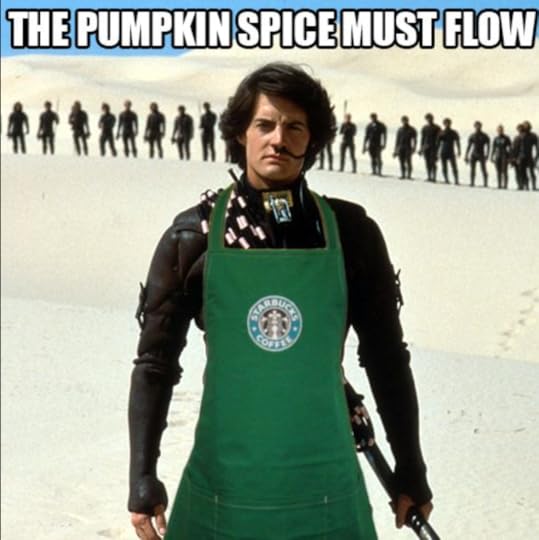
The spice must flow…
Klatu…berata…nickle? Necktie?
Dear eight-pound, six-ounce, newborn Baby Jesus.
Of all the gin joints in all the towns in all the world, she walks into mine.
That’s my spot.
How many of us quote lines from books or movies we’ve not even read or seen?
I’ll make him an offer he can’t refuse.
I have never SEEN The Godfather. Don’t shout me down, I’m just not a huge fan of gangster films. But that has NOT stopped me from pillaging these movies like a crow for shiny bits of dialogue.
Don’t judge me. Y’all are guilty, too.
The point is, I will grant you that Dune 2021 is visually masterful, but when was the last time you shared a meme of something ‘visually masterful?’ Quoted…um, visual mastery? Memed visual mastery?
The point is, without solid story and DIALOGUE we all just sound like a bunch of Sundance geeks or pretentious film students.
“MASTERFUL!”
Me: “You keep using that word. I do not think it means what you think it means.”
Ultimately? Dialogue has tremendous power and resonance. Verbal vs. Visual
Verbal vs. VisualThis could be a symptom of me being an old curmudgeon, but I don’t think so. When it comes to the screen, I feel CGI was one of the worst things that could have happened to screenwriting.
When computers can create everything a writer ever imagined and more, this—more often than not—leads to lazy writing.
So now, we’ll circle back to Dune 2021. Yes, I will admit that part of Dune’s appeal has always been the utterly fantastical world. Vast deserts, sand worms larger than the human mind can conceive, futuristic weapons, folding space, etc.
If you want a ‘visually stunning’ experience, then the remake is for you. Frankly, I kept falling asleep then startling awake wondering how the hell Melancholia ended up in the desert.
 Literally my face watching ‘Melancholia’ and now ‘Dune.’
Literally my face watching ‘Melancholia’ and now ‘Dune.’The special effects are almost sensory overload, and they did a beautiful job bringing this science fiction world to life.
Problem was, I went to the movie for the STORY of Dune as well. If I only wanted to be visually wowed to symphonic music? Um, I’ve already been to the Van Gogh immersive experience in Dallas.
The book, as well as the original movie, have SO MANY quotable lines, which, aside from being memorable, served a very important purpose.
Dialogue and Subtext
Yes, I saw the movie when Toto was still cool. Yet, even as an elementary school kid (yes, I am OLD) who had yet to read the book, I could understand there were so many more layers below the surface.
I can appreciate that the 2021 version was working to differentiate itself from the 1984 version, but there were a number of decisions I found rather perplexing.
First of all, the movie refers to a LOT of information/trivia that ONLY THOSE WHO HAVE READ THE BOOK would even remotely get. This is an almost 900 page book that weighs over a POUND.
For geeks like me who are in the know? Then the painting of the old duke and the bull and the subtle references to plant life make sense. To everyone else? That painting means NOTHING, and everyone else is going to have to wait for the second movie to know WTH the plants are about.
Since they fixated SO MUCH on the visual, there is actually very little talking. And, for the record, a lot of that ‘talking’ was pretty important for a number of reasons.
This is a Test Via ‘Dune’ 1984
Via ‘Dune’ 1984For instance, in the beginning when the Reverend Mother Gaius Helen Mohiam of the Bene Gesserit comes to test Paul Atreides, there is a subtle difference between the two movies.
Paul overhears the Reverend Mother chastising Jessica for having a son, but in the earlier movie (and the book) she makes a proclamation, “For the father…nothing.”
To which Paul freaks out and demands to know why RM is talking about his father as if he’s already dead. This not only foreshadows what is to come, but it SHOWS Paul is still a boy. He’s emotional and reckless with his words. He also has zero clue who he’s talking to and why yelling at this old woman might get him Vader-choked.
Paul has not yet evolved from boy to man, let alone from heir to ruler…let alone into a messiah.
Dialogue and Stating the Obvious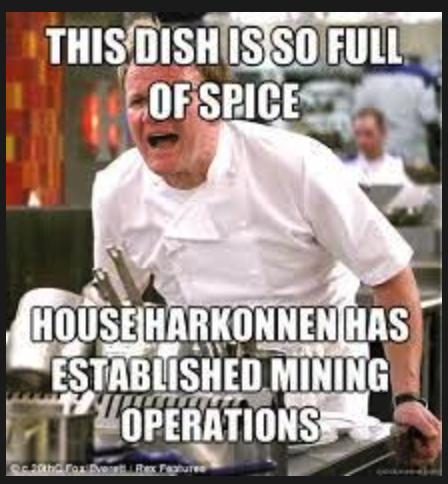
The beauty of the book as well as the original Dune is the notion that a potential messiah was coming. When the RM arrives, she chastises Jessica for daring to believe she could birth the Hooked-On-Phonics-Worked-for-Me Quizat Haderach.
We don’t know what this QH is, other than some sort of super being. OH-KAY. Remember how I preach, and preach and preach about how superlative storytellers excel at being amazing secret keepers?
Yeah, well Dune 2021 just tossed that concept out the window more times than I could count. Because apparently audiences sophisticated enough to keep up with Game of Thrones, Breaking Bad, Deadwood, Battlestar Galactica, Downtown Abbey and more…need everything written out for them with Crayons lest we get lost.
Granted, in the book, this is different, but Frank Herbert had like 750 pages more to work with.
When it comes to movies? Save a little for later, okay? Tantalize us. We like to be woooooed.
Case in point. These snippets of dialogue are from the BEGINNING of the movie *Kristen rails at the heavens*
Gaius Helen Mohiam : You’ve proven you can rule yourself. Now you must learn to rule others, something none of your ancestors learnt.
Paul Atreides : My father rules an entire planet.
Gaius Helen Mohiam : He’s losing it.
Paul Atreides : He’s getting a richer one.
Gaius Helen Mohiam : He’ll lose that one too.
I don’t even have to put in any spoiler alerts. THE Reverend Mother Mohiam does it FOR ME!!!Or how about this?
Paul Atreides : There’s something happening to me. Something waking up in my mind. I can’t control it.
Gaius Helen Mohiam : What did you see?
Paul Atreides : There’s a crusade coming.
WHY DO WE EVEN NEED THE MOVIE?AND THIS is actually a line! Literally NOT joking.
Gaius Helen Mohiam : Arrakis is a death trap.
Thank you, oh Great Stater of the Obvious! Where is a sand worm to crush me when I need one?
 Yes, I made my own meme, LOL…
Yes, I made my own meme, LOL…For the record, for a movie that cut out SO MUCH DIALOGUE? This is NOT how one uses the remaining dialogue.
Part of the reason screenwriting is SO DIFFICULT is it is CRAZY how much you have to jam into a handful of lines without spoon-feeding the audience like they’re braindead.
Short of the Reverend Mother Mohiam or Paul pulling out a Flannel-Graph or a Power Point, they’ve basically spelled everything out in case our teensy-tiny brains couldn’t keep up.
In the book as well as the 1984 movie, we know House Atreides is walking onto a trap, but the story uses the dialogue from other characters to add suspense: voices of warning (Yep, it’s a trap), voices of uncertainty (You sure they’d be so obvious?), and voices of pride (Who cares if it’s a trap? We can outsmart them).
Most of the critical information was delivered to the audience in subtext and vague references that one would NOT fully understand unless one watched the full movie or read the entire book.
Yes, Paul has visions but they make no sense until later. His visions are disjointed and lack context…until he evolves from boy to man to taking The Water of Life (test).
It isn’t until he survives the test, proves he is ‘potentially’ the Quizat Haderach that the visions fall into place in any coherent manner.
The visions serve as foreshadowing, they don’t spell out the entire PLOT OF THE MOVIE.
Also, just because Paul survived The Water of Life did not automatically mean he really WAS the Quizat Haderach. He still had to prove himself in Act Three as liberator, crusader, leader and, ultimately…messiah.
How do we know this? DIALOGUE!
At the end (mini-spoiler alert), Paul’s sister Alia proclaims, “And how can this be? For he IS the Quizat Haderach!”
The only reason she’d need to announce this is if, up until such point in the story, the idea her brother was the Quizat Haderach was somehow in question.
But for the 2021 crowd, I guess that is coming in the second movie.
…hopefully.
Dialogue and Character So many wonderful characters. Too bad they didn’t USE any of them.
So many wonderful characters. Too bad they didn’t USE any of them.We can tell a lot about a character’s arc from dialogue, as I noted above. But, with the new Kylo Ren Paul Atreides, he’s completely flat.
In the book and earlier movie, Paul had super abilities as well, partially from his mother’s training. Yes, he passed the test with The Box, he knew instinctively how to wear his still-suit desert-fashion, he had visions…but always with heavy dose of immaturity and childlike astonishment.
It’s only later that Paul remotely evolves into the stoic leader that the remake hands us almost from the outset.
There’s a crusade coming *Resting Paul Face*
Good to know!
What really saddened me about them removing SO MUCH dialogue from the movie is that—pay attention writers—dialogue is what adds dimension to characters.
In the new Dune? They did very little with the characters. I was actually shocked they’d made such a big deal about Jason Momoa being in the new movie since he has like three lines and is barely present.
Same but DifferentBefore anyone gets too upset, I agree, the new Dune is *mumbles* visually breathtaking. In fact, over the holiday, knock ourself out. Go to an IMax theater for the full visual and symphonic experience.
But, I’m talking about story today.
In the remake—due to plain awful or missing dialogue—most of the characters were interchangeable and had the depth of an Instamodel Real Housewife.
This did NOT have to be the case.
I was very pleased to see references from the book (as I mentioned above), and TRUST ME. There was MORE than enough dialogue the new screenwriters could have taken from the book so as not to copy the old movie.
ALMOST 900 PAGES WORTH!
As for the movie, I loved how they reimagined the Baron Vladmir Harkonnen. In the 1984 movie, they couldn’t get into nuance and so they made up for it with shock value.
Conversely, in the 2021 version, the Baron is MUCH more like the political shark he’s portrayed to be in the book.
I also LOVED how they reimagined Dr. Lyet Kines…except then they practically did NOTHING with her. Sadly, many characters who could have been SO MUCH MORE…fizzled or disappeared.
Here’s hoping for Part Two, though not holding my breath.
And if you want a laugh, Honest Trailers apparently thought a lot of the same things I did (it’s PG-13 so you know)…
What Are Your Thoughts?Oh, I am bracing for it. I KNOW IT WAS VISUALLY MASTERFUL! That’s already been stated for the record. I’d hoped it wouldn’t simply be a retread of the 1984 film, but—since we’re referencing the 80s—where’s the BEEF?
In my POV, if they were going to retell Dune it should have been done in a long series like Game of Thrones. It is just THAT deep of a story.
I can see why the remake relied heavily on visual effects and musical scores that make film festivals all weepy-eyed. For those who were going to see it over the holidays…um, sorry but it IS VISUALLY MASTERFUL! 
So what are your thoughts? Am I being too hard? Did I miss something (I DID mention I kept falling asleep)? Is there some nuance I overlooked?
Did you miss the dialogue from the book and older film? Am I the only one who thinks they could have done more with such a great cast of characters?
What are some your favorite lines of dialogue from movies, Dune or otherwise?
The post Dune, Dialogue, Wishing Sand Worms Would Kill Me appeared first on Kristen Lamb.



